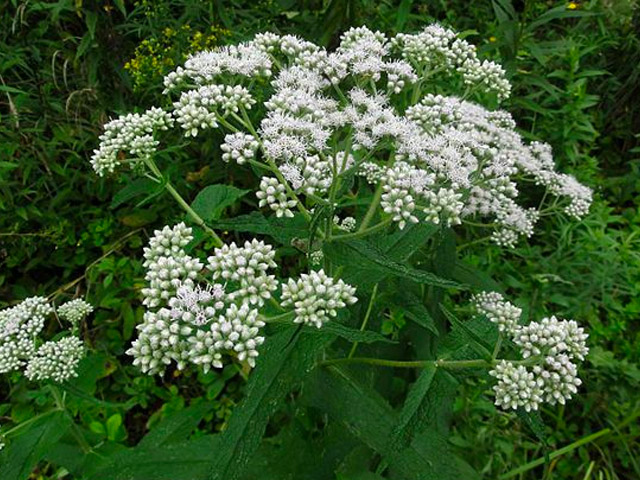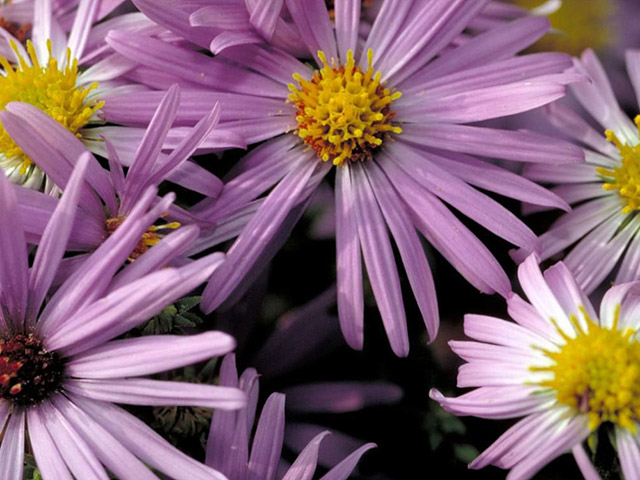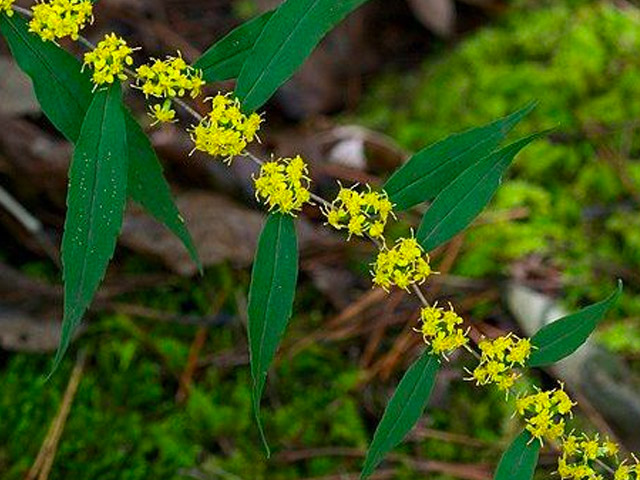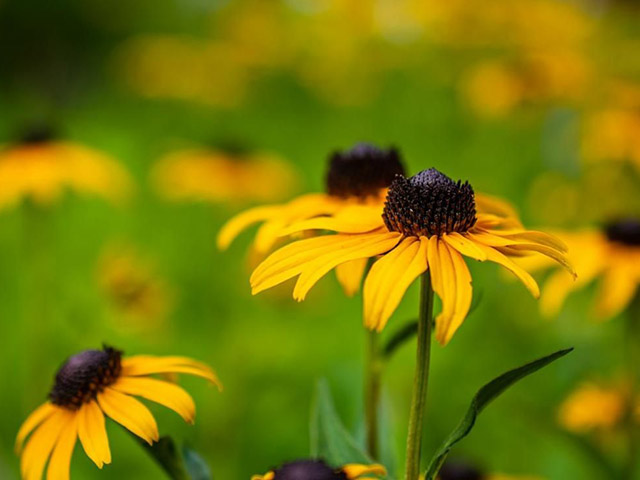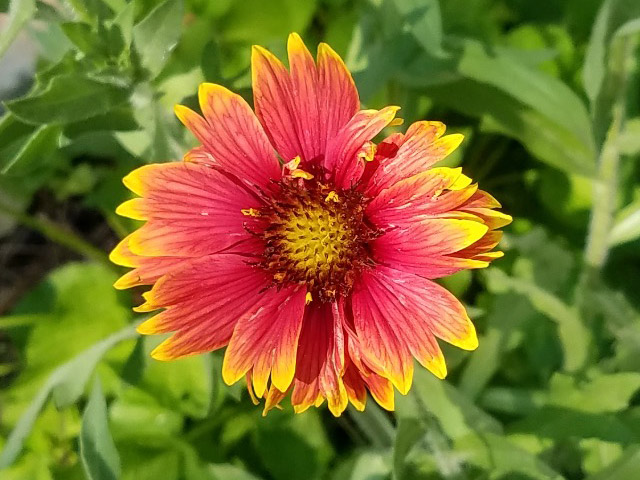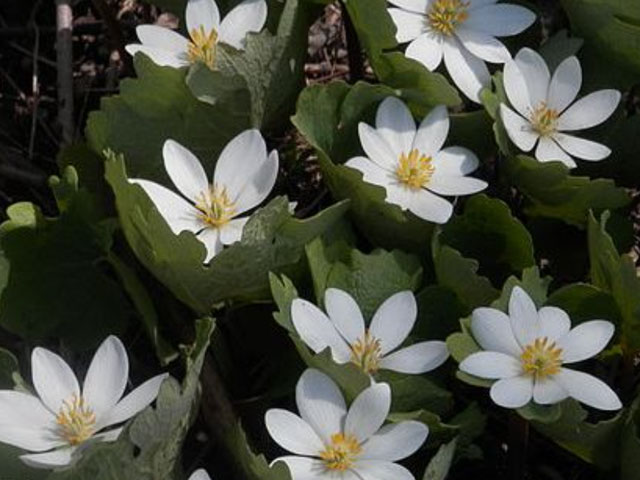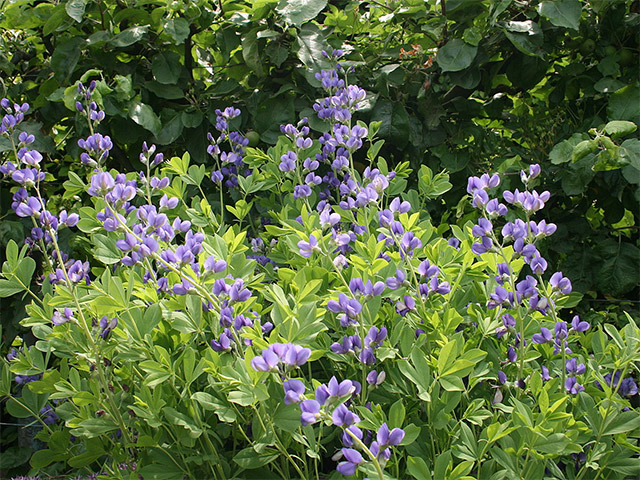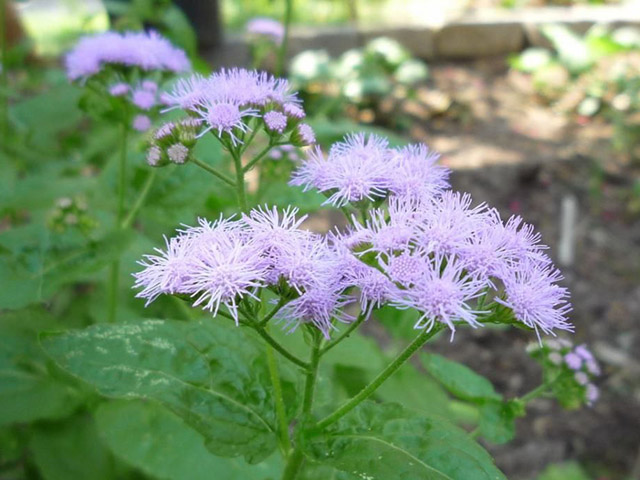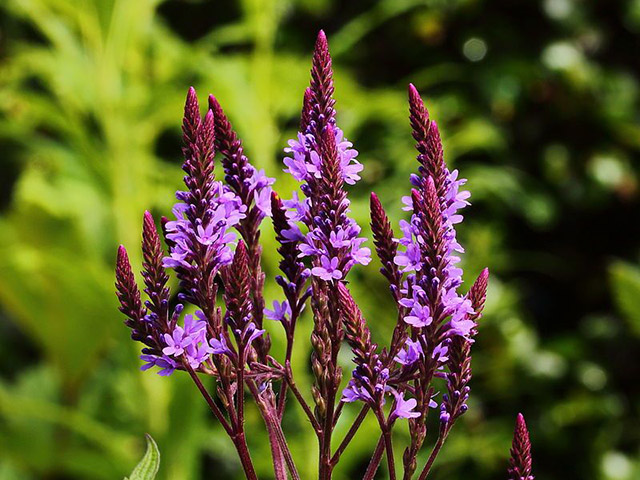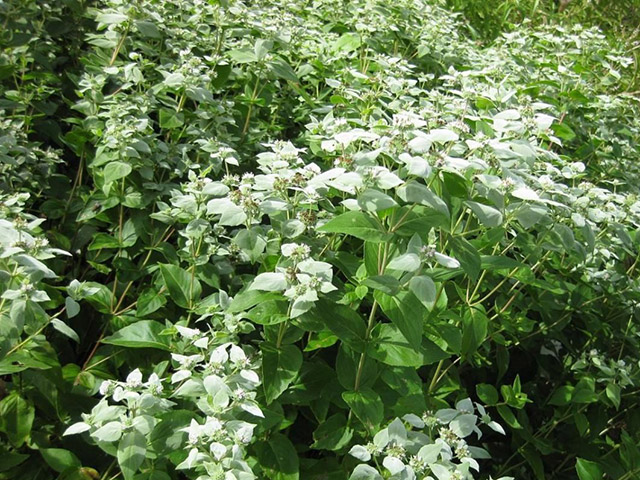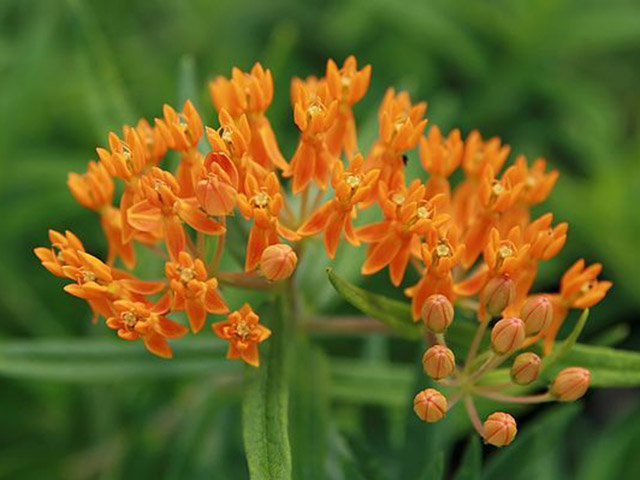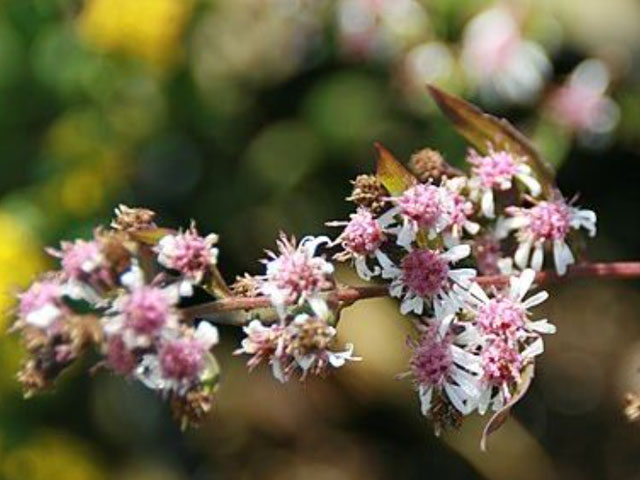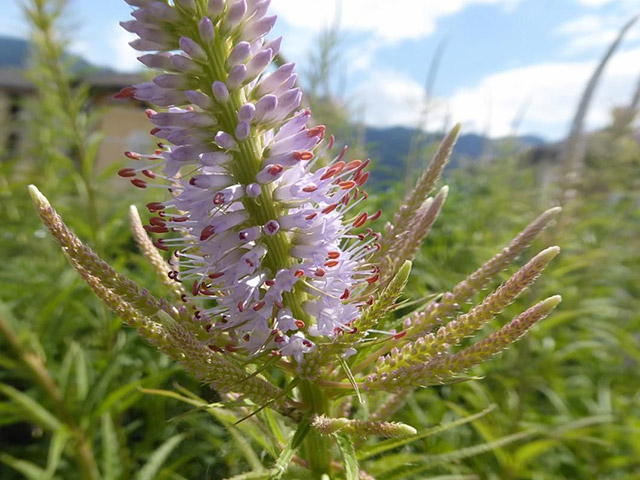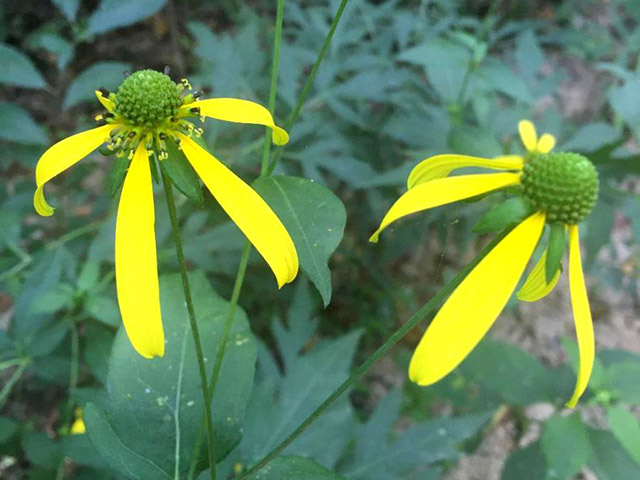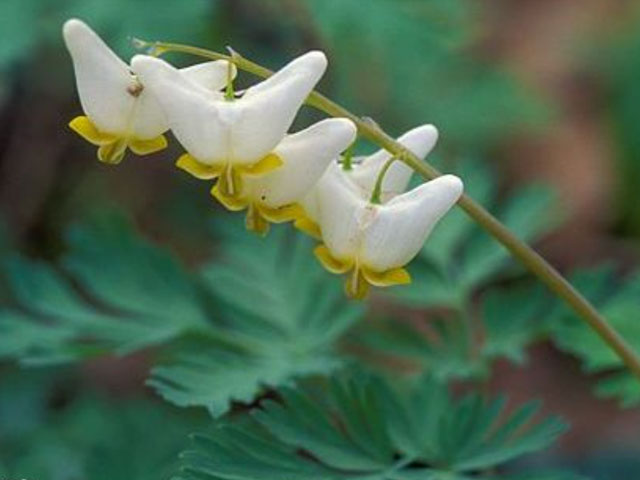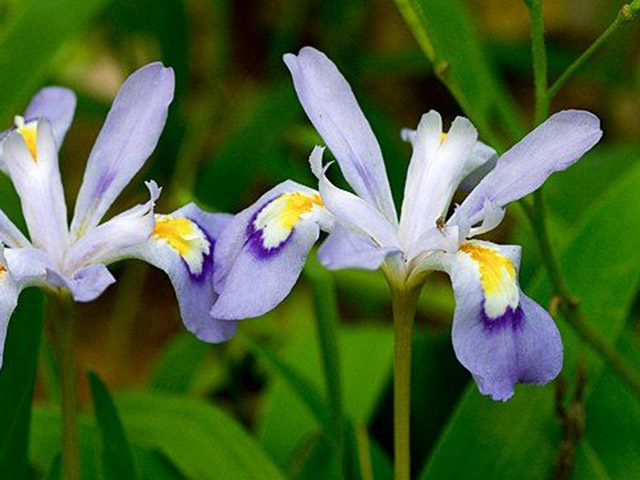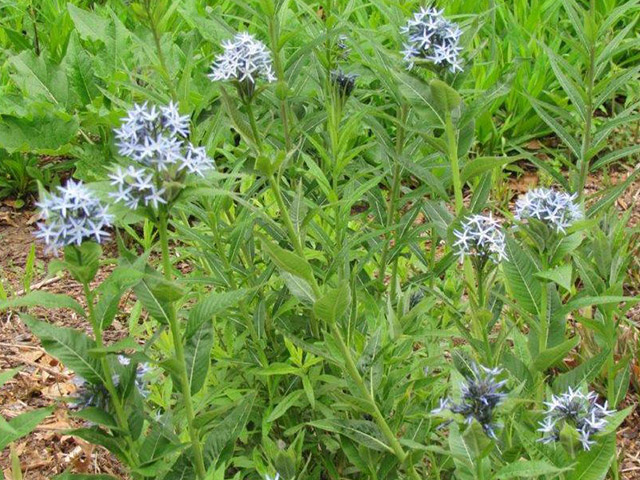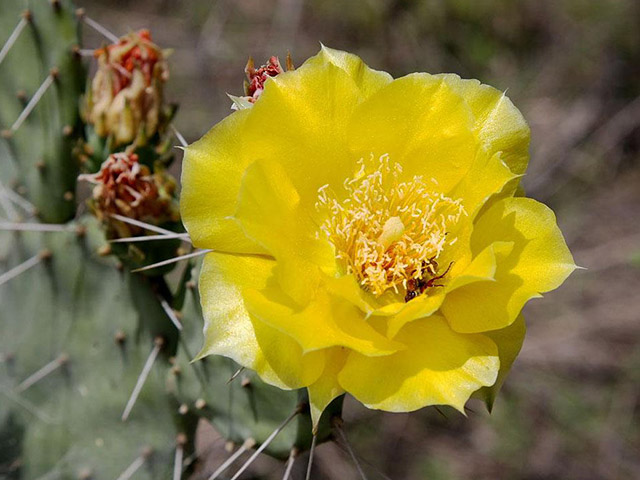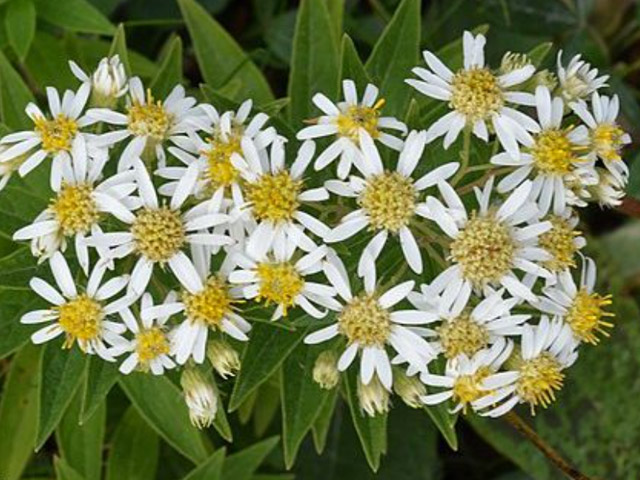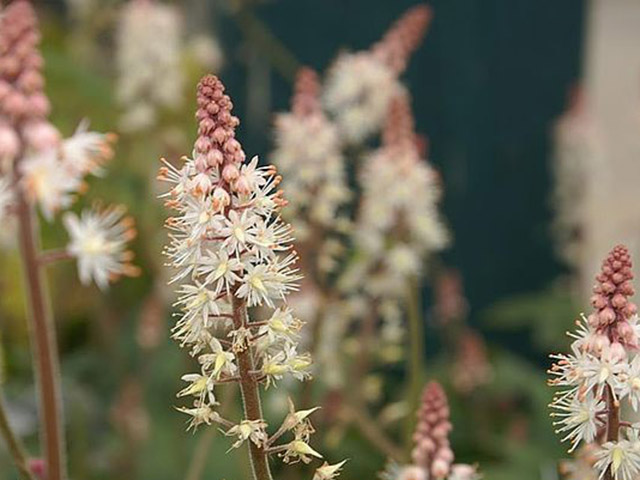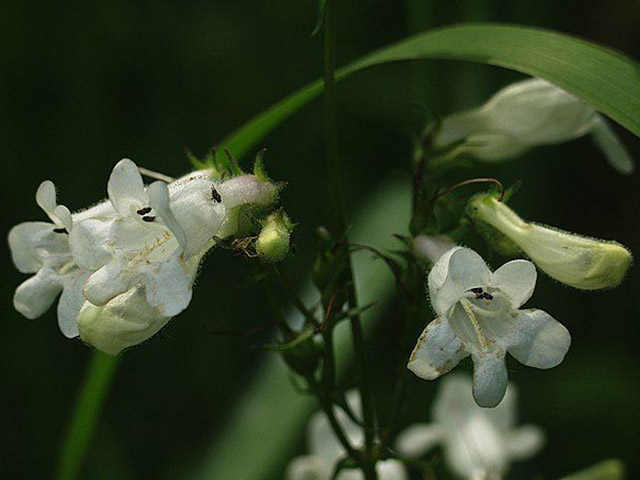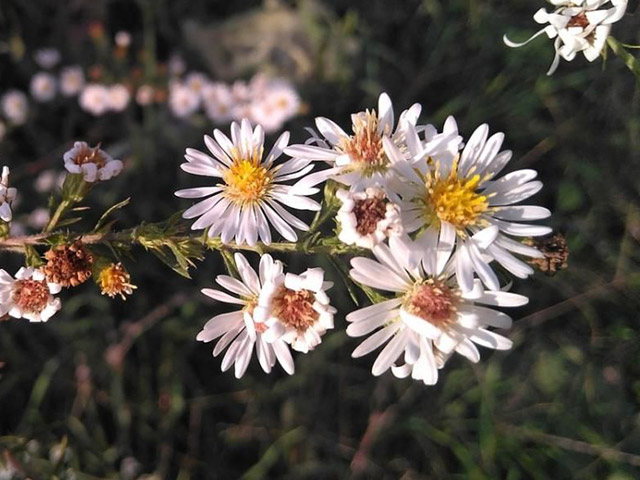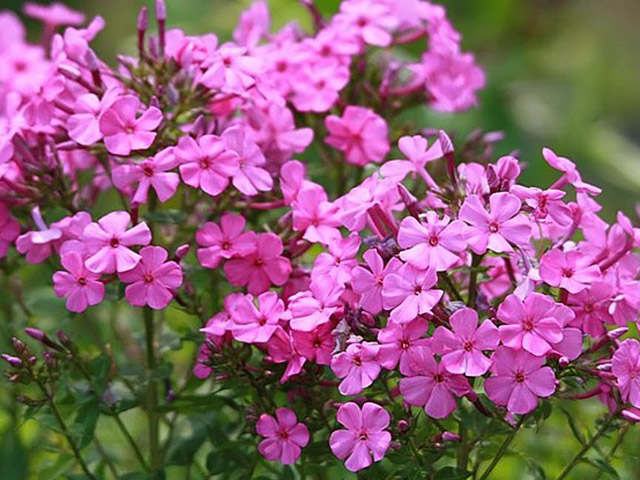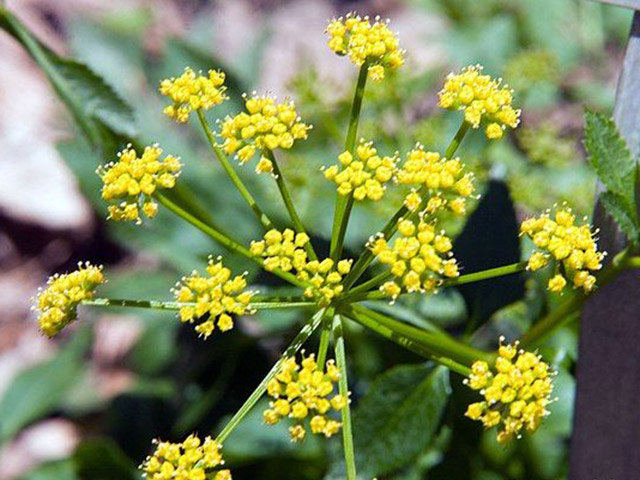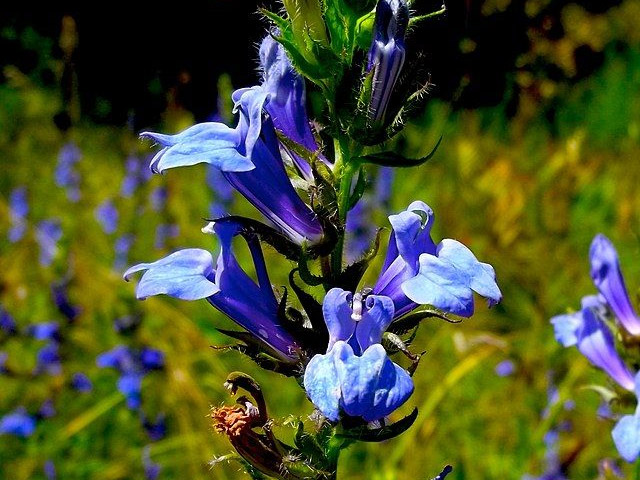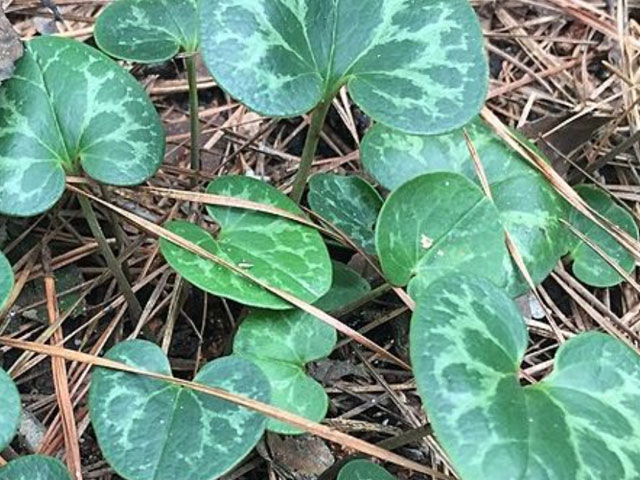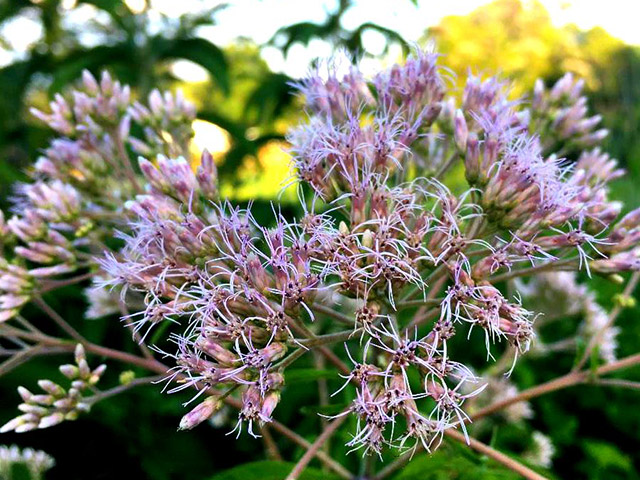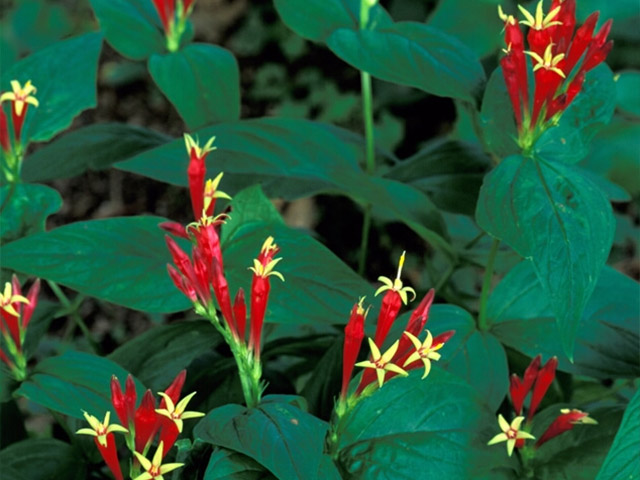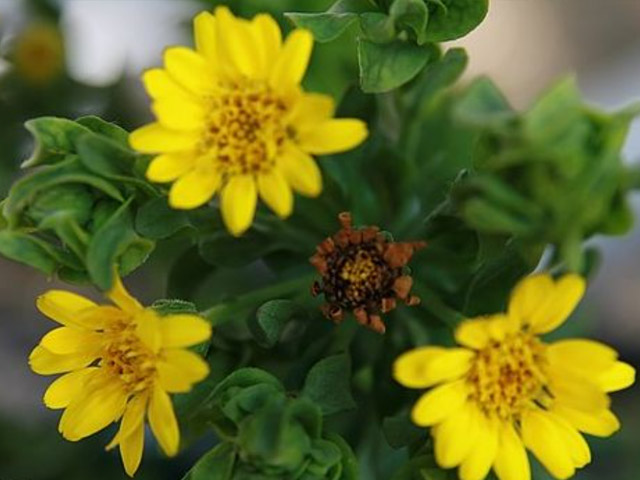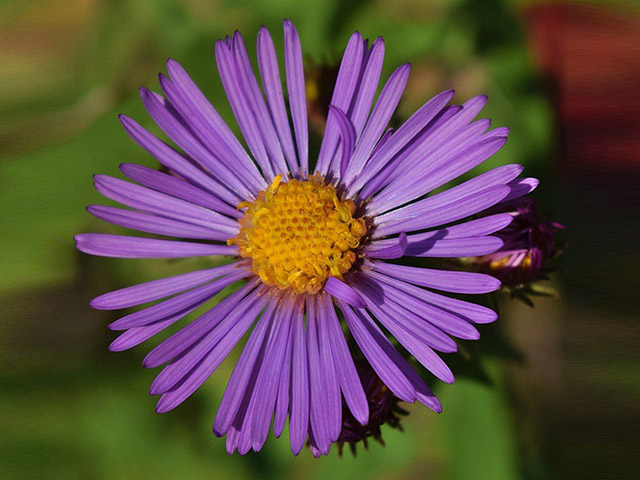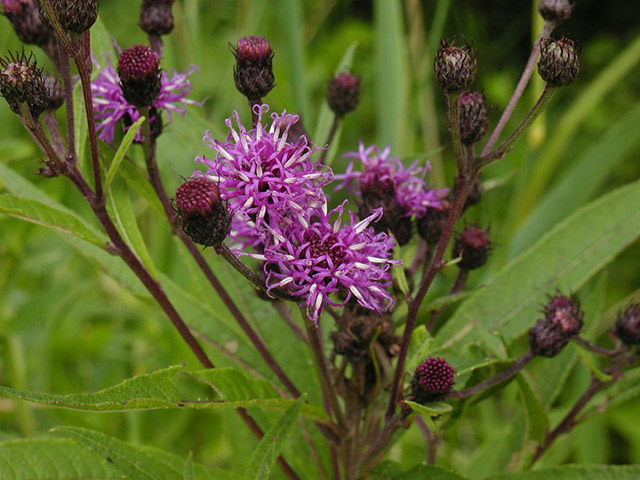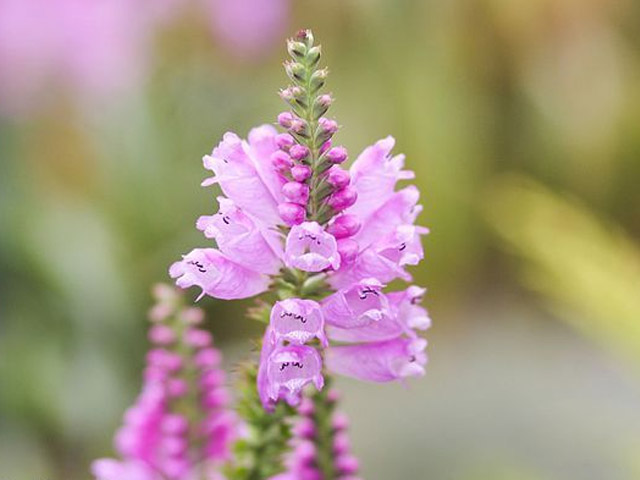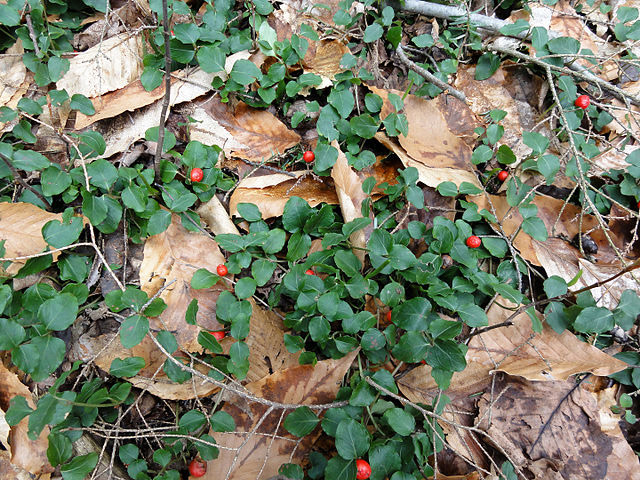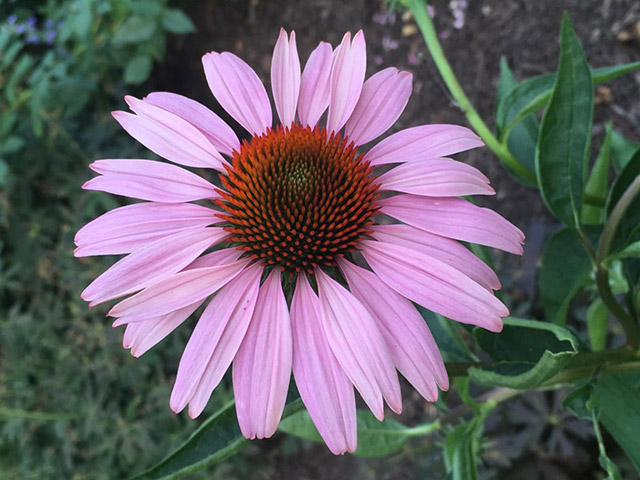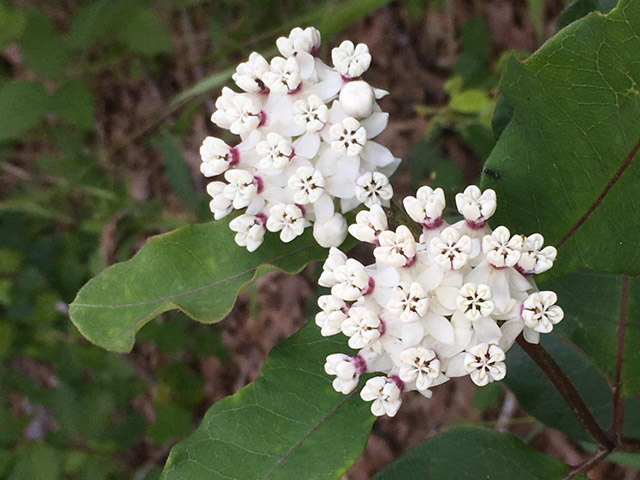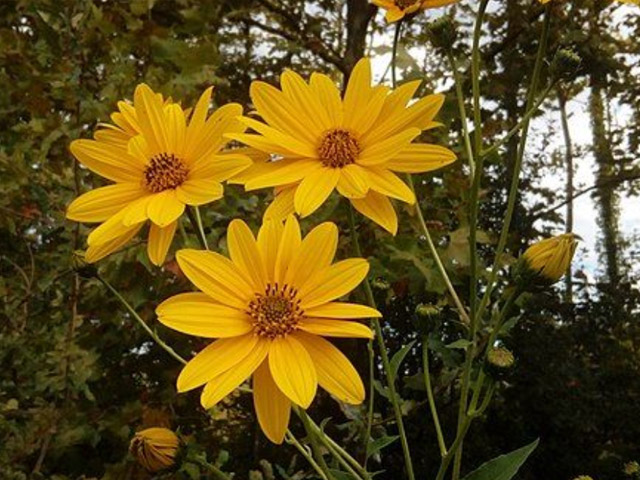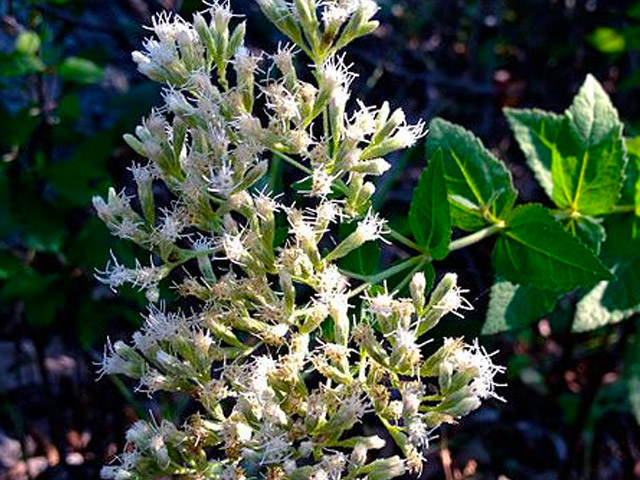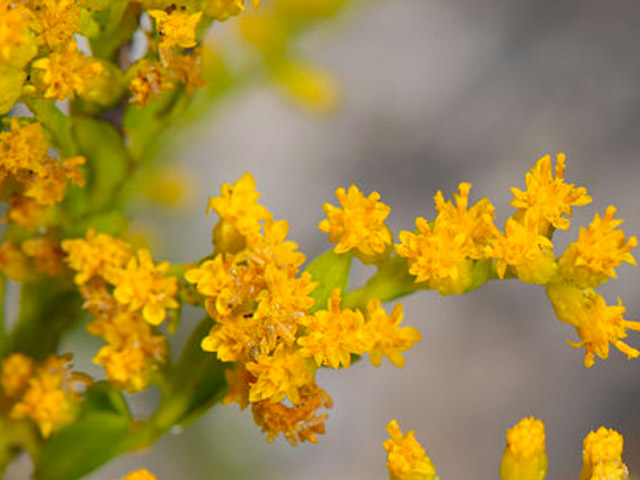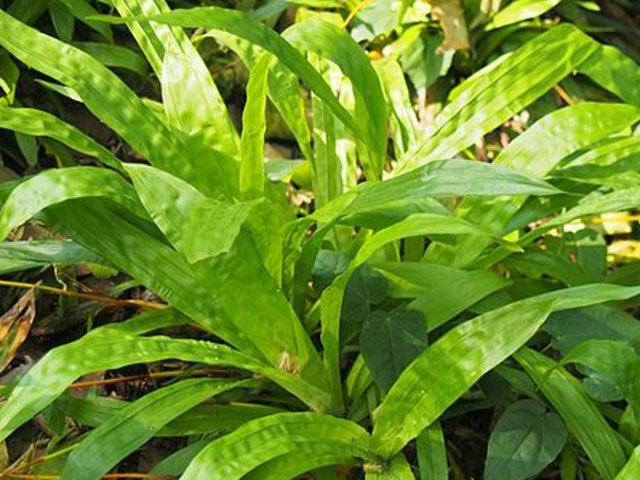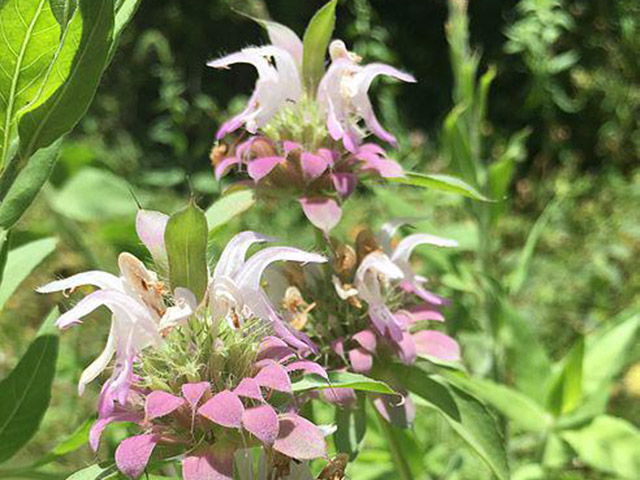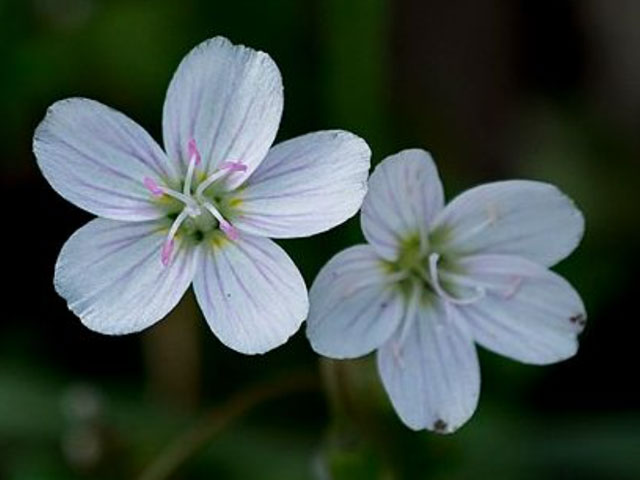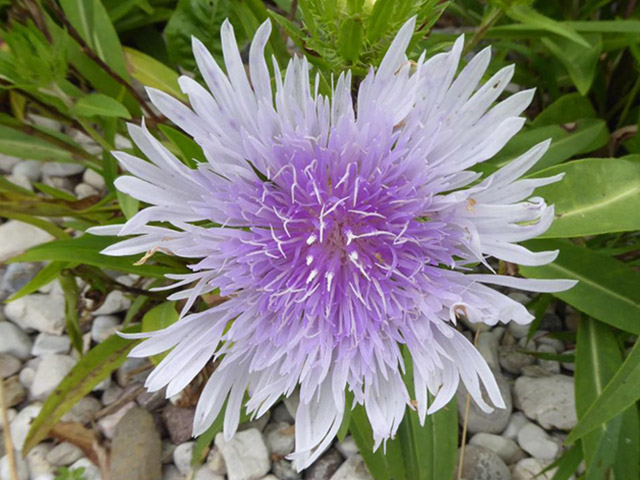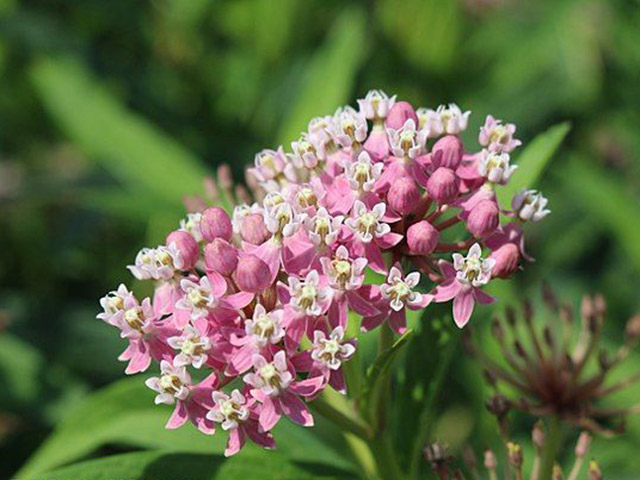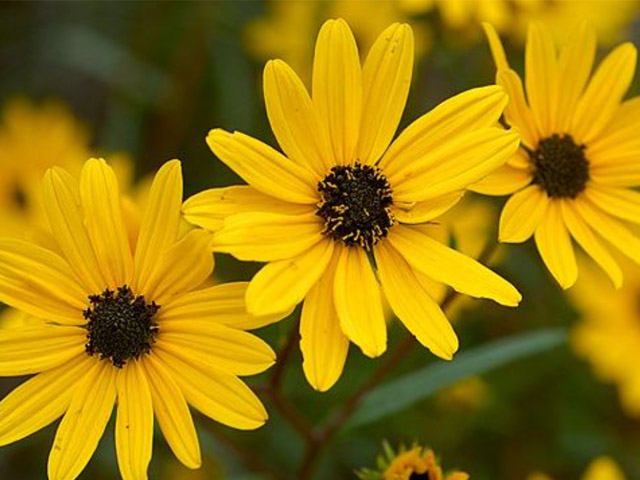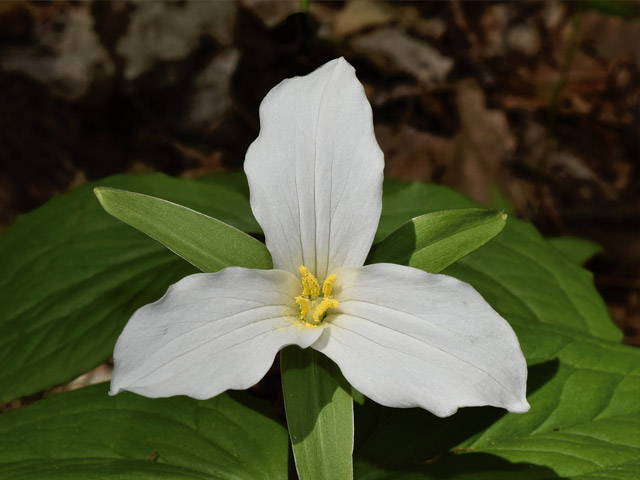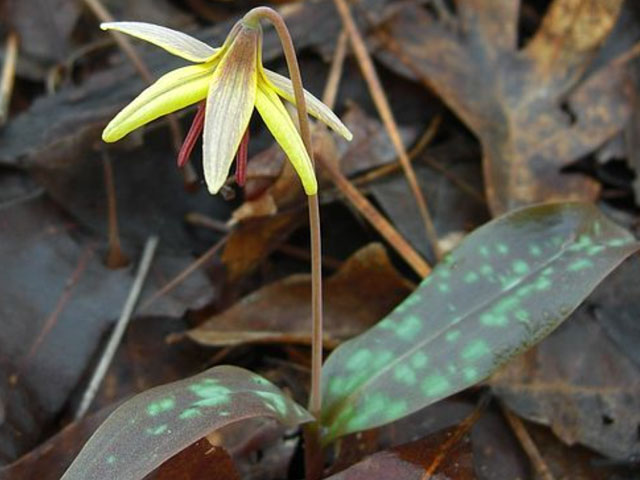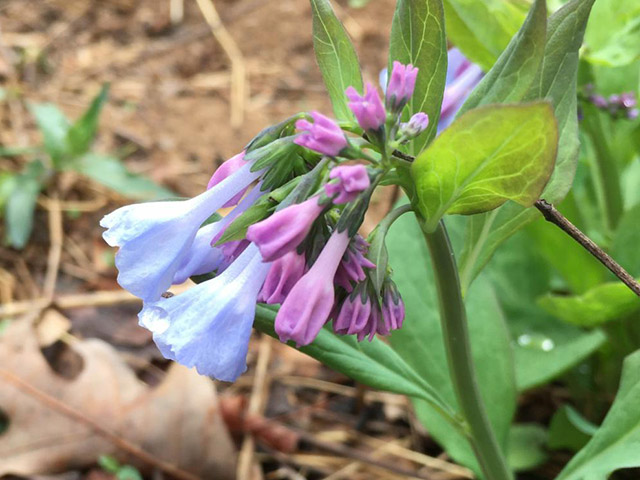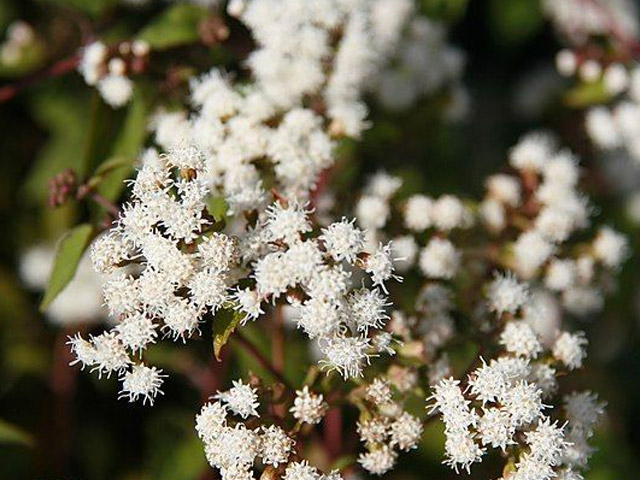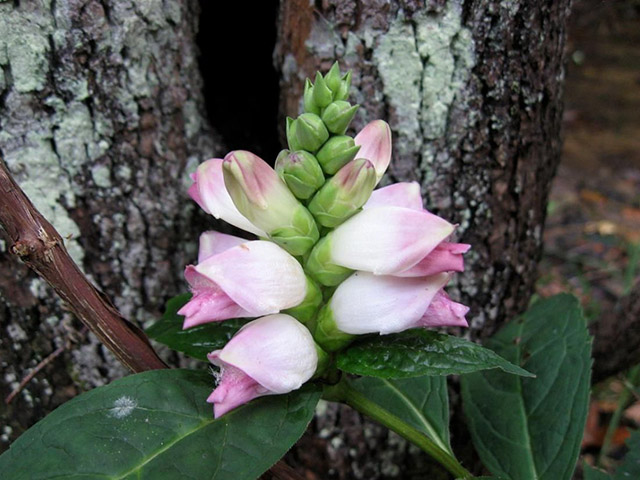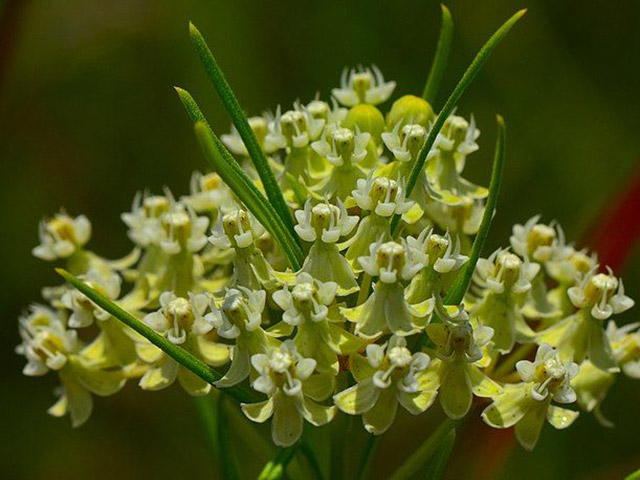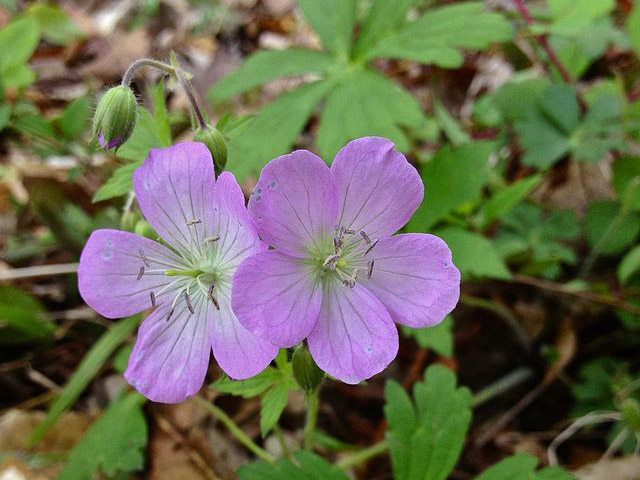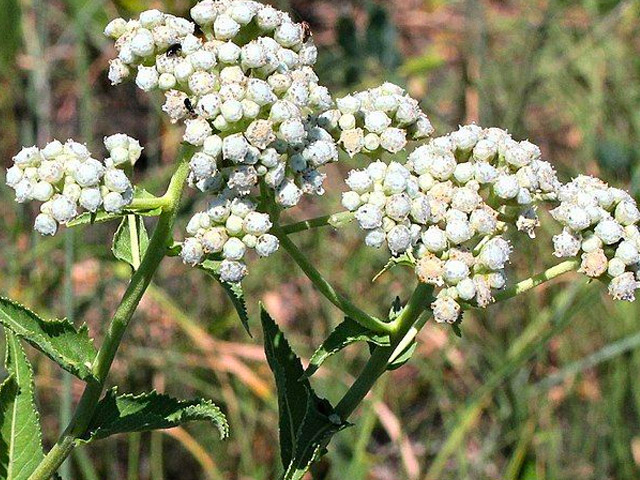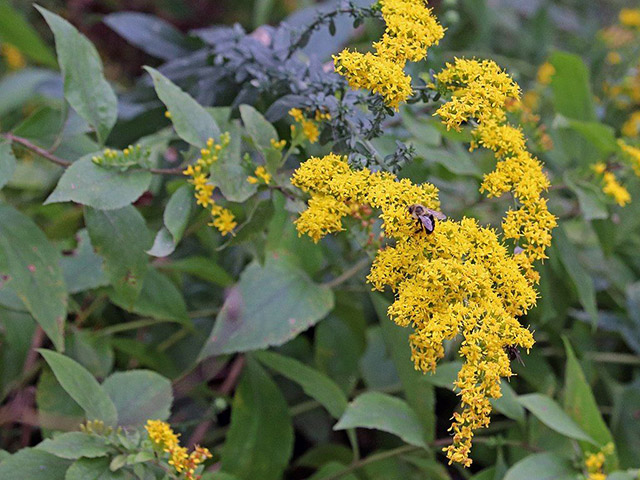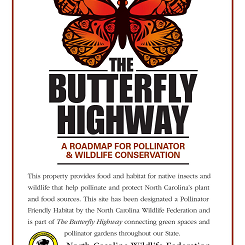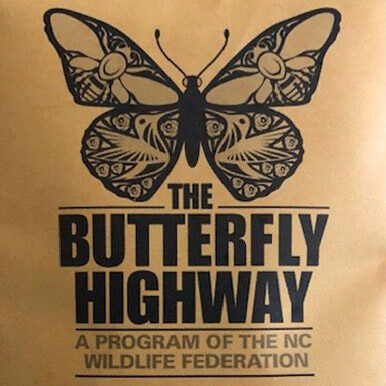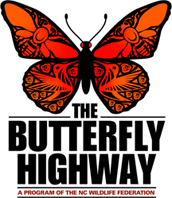Native Pollinator Perennial and Annual Flowers
Recommended Flowering Perennials and Annuals
Perennials have a longer lifespan than annuals and will come back year after year. Whether perennial or annual, native pollinator plants set deeper roots so they capture and filter higher amounts of stormwater runoff. This helps reduce flooding during extreme weather events and saves water since these require less watering after being established. Gardeners benefit because these plants are more resilient to drought, climate change and other adverse conditions.
Below is a list of suggested perennials native to North Carolina. Many of the trees listed can be found in all three major regions of North Carolina (Piedmont, coastal, mountain). This list isn’t intended to be comprehensive and only highlights a selection of native trees that many nurseries and garden centers are likely to carry.
For a more comprehensive list, see NCWF’s suggested North Carolina regional native plant list. You can also purchase NCWF's custom Butterfly Highway seed packets, which include seeds for up to 10 native plants that support pollinators and other wildlife.
To stay informed on pollinators and native plants, habitat restoration resources and what’s flying and blooming across North Carolina, sign up for The Butterfly Highway newsletter.
Get access to the NCWF Pollinator Plant Bloom Calendar to learn when our native pollinator plants are in bloom each year by signing up for the NCWF Butterfly Highway Newsletter.
North Carolina Native Plants and Flowers
American Boneset
American Boneset, Eupatorium perfoliatum, is an herbaceous perennial that is native to the southeastern region of North America. It is naturally found growing in low woods, thickets, stream banks, meadows and prairies.
American boneset is a clumping perennial that reaches a height of 4 to 6 feet tall. It can be planted in full sun or partial shade and grows in a variety of soil types. While it can tolerate brief periods of flooding, it prefers moist, well-draining soils.
In late summer and into fall, boneset can be distinguished by its erect growth habit and flat-topped clusters of white flowers. The flowers provide pollen and nectar for bees, butterflies and other pollinators. Its green, fuzzy leaves may host 30 or more moth and butterfly species.
Once pollinated, the florets develop seeds with hairs attached to one end that are dispersed by wind. The seeds may attract songbirds.
American boneset is appropriate for several garden styles including rain gardens, pollinator gardens, butterfly gardens or naturalized areas.
Fun Fact: American boneset was historically used as a medicinal plant in treating the flu, fevers, colds, and other sicknesses, but is not advised for medicinal use in modern times.
Aromatic Aster
Aromatic aster, Symphyotrichum oblongifolium, is an herbaceous perennial that is native to the eastern and central regions of North America.
It can be found growing naturally in limestone glades, prairies, dry woodlands and on slopes, as it is very tolerant of dry soil conditions. It prefers dry to medium soil moisture but will grow in a variety of soil types including sandy, loam, rocky or clay soils.
Aromatic aster gets its name from the fragrance released when its leaves are crushed. The plant can be identified using this scent or by its blue-green oblong leaves. Aromatic aster typically blooms well into fall and is characterized by its purple, daisy-like flowers which attract a variety of bees and butterflies. It will add fall color to your garden beds, and provide nectar and pollen to late-flying pollinators.
Reaching a height of 1-3 feet tall, aromatic aster is commonly planted as a ground cover or in mass plantings. It is a great addition to a pollinator garden, prairie garden or open woodland garden as long as those areas receive full sun to partial shade. Aromatic aster can be found in some native plant nurseries, or it can be propagated by seed following cold stratification.
Fun Fact: Aromatic aster colonizes an area readily and may need to be thinned or divided to regulate growth.
Axillary Goldenrod
Axillary goldenrod, Solidago caesia, is an herbaceous perennial that is native to eastern and central North America. It can be found growing in woodlands, streambanks, forest edges and fields.
Axillary goldenrod has a clumping habit with arching stems which typically grow one to four feet tall. It grows best in full sun to partial shade and prefers moist, well-draining soils. Axillary goldenrod can be found and grown in all three regions of North Carolina.
From late summer and into fall, small clusters of bright yellow flowers develop and bloom in the leaf axils on the stems. These flowers will attract a variety of pollinators including bees, flies, and small butterflies. Dark green leaves are borne on a bluish-purple stems and are the host plant for several moths and butterflies, including the wavy-lined emerald moth.
Once pollinated, axillary goldenrod produces seeds that are eaten by songbirds. Unlike other goldenrods, axillary goldenrod is more well-behaved and does not spread aggressively in the garden.
Axillary goldenrod is a low maintenance plant that can be added to a rain garden, woodland garden, pollinator garden or naturalized area.
Fun Fact: Goldenrods are dependent on pollinators to move their pollen, but have commonly been blamed for fall allergies. Ragweed is the culprit for fall allergies.
Black-eyed Susan
Black-eyed Susan, Rudbeckia hirta, is an herbaceous perennial that is native to the eastern half of North America. It is naturally found in open woodlands, meadows, ditches and prairies. Its ability to adapt to different soils makes it a great garden plant for any region of North Carolina. It is best to plant them in well-draining soil to prevent root rot and to plant them in full sun to partial shade for best floral performance.
Black-eyed Susans are a very popular garden plant due to their long bloom times which bring long-lasting color to a garden bed. Their slightly hairy and scratchy leaves make them less palatable to deer and rabbits, though their new leaves may get nibbled on in the spring. They have an erect habit, growing 2-4 feet tall, with branched flowers appearing in mid summer to early fall. Their bright golden petals not only make a statement in the garden, but they also attract a variety of pollinators. Bees and butterflies can both be seen visiting black-eyed Susan for nectar and pollen. It is the host plant as well for the gorgone checkerspot butterfly. Once the seeds are ripe, songbirds such as goldfinches and sparrows will forage on the seedheads.
They reseed readily and grow easily in disturbed soils making them a popular component of native seed mixes. They can reseed in your garden as well, but competition from other plants helps keep their populations in check. In a garden setting, black-eyed Susan are commonly planted along borders or in mass in a pollinator garden. They are also excellent plants for a naturalized area or meadow garden.
Fun Fact: Black-eyed Susan roots were used by Native Americans to treat colds, sores and swelling.
Blanket Flower
Blanket Flower, Gaillardia pulchella, is an annual found naturally occurring in sandy habitat and can be a prolific sight on the North Carolina Barrier Islands. They have a prolonged bloom time and will begin blooming in late May and continue until frost. Their blooms consist of red, orange and yellow colors and they have green, fuzzy leaves. Blanket flower is highly tolerant of sandy soils and of salty conditions making it an excellent choice for gardens with those tough garden circumstances. It is a good flower to incorporate into a meadow garden, rock garden or cottage garden given that it will naturalize well and provide lots of color for most of the year.
Blanket flower provides pollen and nectar which attracts both bees and butterflies and makes it an excellent choice for a wildlife garden. Once pollinated, seeds will develop and form a fuzzy-looking seed ball. Seeds will either disperse in the garden for next years crop or be eaten by wildlife such as songbirds, notably goldfinches, or other wildlife.
The most common blanket flower in garden stores is Gaillardia x grandiflora which is a cross between G. pulchella (native to NC) and G. aristata (native to the midwestern States). G. pulchella may be difficult to find in garden stores, however, they are very commonly included into wildflower mixes. They are best grown by sowing seed directly onto soil. The image above is from one of our staff members who grew it from NCWF's previous seed packets!
Fun Fact: The name of this flower originated due to the colors of the flower resembling the colors found on Native American blankets.
Blazing Star
Blazing Star, Liatris spicata, is an herbaceous perennial native to the eastern half of North America. Look for it naturally growing in marshes, mesic prairies and moist, open woodlands.
Blazing star has an erect, clumping growth habit, and reaches a height of 3-6 feet. It is adaptable to many different soil types but prefers moist, well-draining soils. Blazing star performs best in full sun, but can also grow in dappled shade.
Often planted in perennial borders, blazing star has proven a dependable pollinator plant due to its tolerance of North Carolina's summer heat and humidity.
In mid-summer, blazing star shoots up a tall spiked inflorescence covered with clusters of purple-pink blooms. These bright blooms attract an abundance of native bees, butterflies and other pollinators.
The linear, green leaves get smaller as they go up the stem. In fall, pollinated flowers develop seeds that may attract goldfinches and other songbirds. The leaves may also serve as food for two native moths: Liatris flower moth and Liatris borer moth.
Blazing star is a show-stopping addition to a rain garden, pollinator garden, meadow garden or cottage garden.
Fun Fact: The flowers bloom from the top down rather than bottom up.
Bloodroot
Bloodroot, Sanguinaria canadensis, is a spring ephemeral that is native to the eastern half of the United States and Canada. It can be found growing naturally in moist deciduous forests and slopes primarily in the western half of the state, although it can be grown in all three NC regions.
Bloodroot is a colony-forming perennial, spreading by underground rhizomes over time. They only reach a few inches tall, making a beautiful display on the woodland floor. They prefer habitats that are in full shade or partial shade along with moist, well-draining soil.
The flowers emerge in early spring with a deeply-lobed leaf wrapped around the single-stalked flower. Bloodroot attracts a variety of bees and other pollinators. While songbirds may forage the seeds, bloodroot is known to be mainly dispersed by ants who eat the outer coating of the seed and disperse it elsewhere.
Bloodroot can be added to a woodland garden, shade garden, rock garden or raised beds.
Fun Fact: Bloodroot is named for the reddish-orange sap that the plant exudes when crushed.
Blue False Indigo (Baptisia)
Blue false indigo, Baptisia australis, is a robust perennial with a bushy appearance. In the spring, it sends up a tall flower spike with purple, pea-like flowers. It sports blueish-green leaves that add nice color to a garden. Seed pods develop later in the summer making another attractive feature. Typically found in wood edges or prairies, False Indigo is a great plant to add to a variety of pollinator garden styles including prairie gardens, meadow gardens or naturalized areas. It's fibrous root system and its tolerance to clay soils, stony soils and drought make it a great plant choice for stabilizing banks and preventing erosion.
Fun Fact: The name "false indigo" refers to the early American colonists who used the false indigo plant as a substitute ingredient in the making of purple dye.
Blue Mistflower
Blue mistflower, Conoclinium coelestinum, is an herbaceous perennial that is native to the central and eastern regions of North America. It can be found naturally growing in low woods or woodland edges and in wet meadows or ditches. It prefers medium soil moisture but will grow in loamy, sandy or clay soils. Growing 1 to 3 feet tall, it can be planted in front of several taller plants to make a very attractive garden display. Blue mistflower typically blooms from late summer to late fall and is identified by its feathery purple-blue flowers that bloom in flat-topped clusters.
It's bright purple-blue flowers hold an abundance of pollen and nectar that will attract bees and butterflies in the late summer and fall. It is particularly beneficial to late flying pollinators who can be seen swarming this plant when few other plants are blooming.
Blue mistflower is an excellent pollinator plant for full sun to part shade areas. While it is great for pollinators, it can become overly aggressive in the garden due to its habit of spreading through underground rhizomes. Due to this aggressive behavior, it is best to plant blue mistflower in a naturalized garden area or in container gardens. It can also be planted in woodland gardens or rain gardens, but division may be necessary to keep blue mistflower from overtaking the garden bed.
Fun Fact: Blue mistflower can be propagated by division, root cuttings or seeds.
Blue Vervain
Blue vervain, Verbena hastata, is a short-lived herbaceous perennial that is native to eastern and central North America. It is typically found in moist prairies, fields and thickets in both full sun or partial shade. It is distinguished by it's multi-branched and clumping growth habit. Blue vervain may grow anywhere from 3 to 6 feet tall with each stem getting topped with a spike inflorescence in the late summer. Born on the terminal ends of the stems, these inflorescences are made up of numerous blue-violet tubular flowers. The blooms begin opening starting at the bottom and work their way up to the top.
The tubular flowers are a pollinator attractant mainly for bees and butterflies. It has a special value to native bees who specialize on gathering pollen and nectar from these flowers. It is also one of the several larval host plants for the common buckeye butterfly. Songbirds, such as cardinals and juncos, will eat the seeds in the fall.
Blue vervain is best planted by seed although several nurseries also have blue vervain as container plants or as plugs. In order for the seeds to germinate, they must undergo 30 days of stratification (30 day cold period) and be planted with sufficient light.
Due to its preference for wet soils and its tolerance for short-lived inundation, blue vervain is an excellent garden choice for rain gardens, pond gardens, meadow gardens or naturalized areas. It can self-seed in a garden as well but it shouldn't become aggressive due to it's short lifespan of about 2 years.
Fun Fact: Blue vervain has been used as a medicinal herb to treat headaches, coughs and fevers.
Blunt Mountain Mint
Blunt mountain mint, Pycnanthemum muticum, is an herbaceous perennial in the mint family. It can be found naturally in meadows, fields and low woodlands across central and southeastern parts of the United States. It prefers medium moisture but can tolerate some drought conditions as well.
Blooming from July to September, the flowers of blunt mountain mint attract a variety of pollinators with the most common visitors being butterflies and bees. Blunt mountain mint is a particular favorite of hairstreak and buckeye butterflies, along with a variety of bees, which can be seen visiting the flowers throughout the day.
The flowers emerge on the terminal ends of the stems and create a flat topped appearance. The blooms are typically light pink or white in color with silvery green bracts, making an attractive display in the garden. The plants thrive in full sun to partial shade and can grow 1 to 3 feet high. It is a clumping perennial that is best planted en masse in a meadow or prairie style garden or along borders in naturalized gardens. Blunt mountain mint can be separated and divided in the fall or spring to control the size of the clumps.
Fun Fact: The leaves smell like spearmint when crushed and were historically made into teas by Native Americans to treat colds and fevers.
Butterfly Weed
Butterfly weed, Asclepias tuberosa, is a native herbaceous perennial found in the central and eastern parts of North America. It occupies open habitats such as fields, prairies, roadsides, and open woods.
Butterfly weed typically reaches 1-2 feet tall. It is best planted in full sun with dry to medium soil moisture, but it can also tolerant drought and poor soils. This plant's erect and slow growth habitat makes it an excellent addition to the front of a perennial border or other landscape features. Butterfly weed can be grown in all three regions of North Carolina.
From May to August, butterfly weed produces clustered cymes of yellow to orange blooms that attract a variety of bees, butterflies and other pollinators. Deadheading can extend the blooming period.
Bright green, linear leaves persist through the summer and crescent-shaped seed pods develop from summer into early fall after the flowers are pollinated and the blooms subside. The pods open to reveal a showy display of brown seeds with silky tufts of trichomes on one end that aid in wind dispersal.
Butterfly weed and other milkweed varieties are the only larval food source for the monarch butterfly. Once-abundant, wild milkweed populations have steadily vanished from landscapes, contributing to a severe decline in monarch populations in the last 20 years. Planting milkweed and other natives supports pollinator populations that require specific plants to complete their life cycles.
Butterfly weed is commonly added to butterfly gardens, native plant gardens, meadow gardens or naturalized areas. It can also be incorporated into a container garden or rock garden.
Fun Fact: Unlike other milkweeds, butterfly weed does not have the milky sap in its stems.
Calico Aster
Calico aster, Symphyotrichum lateriflorum, is an herbaceous perennial that is native to the central and eastern regions of North America. It can be found naturally growing in forest edges, stream borders, meadows, prairies, roadsides and riparian habitats. It occurs in all three regions of North Carolina.
Calico aster has an erect, clumping growth habit and can grow up to two or three feet tall. It can be pruned to have a neat shrubby appearance- perfect for borders or hedges. This aster can be planted in full sun to partial shade, however, it may perform better receiving afternoon shade in hotter climates. Calico aster should be planted in moist, well draining soil, though it will tolerate drought conditions once it is well-established.
Calico aster will bloom from late summer until first frost. Its flowers grow in panicle clusters along the stems and attract a variety of pollinators. The daisy-like flowers are usually white with pink-lavender or yellow centers. It has simple, alternate leaves attached to green or copper colored stems that are covered in fine, white hairs. In fall, the seeds may attract small mammals and songbirds to your garden.
Calico aster is an excellent addition to any garden in need of a fall flower display. Try adding it to your rain garden, meadow garden, or shade garden. You may also incorporate it into a natural area or woodland garden.
Fun Fact: Calico aster is also a host plant for the silvery checkerspot and pearl crescent butterflies.
Cardinal Flower
Cardinal flower, Lobelia cardinalis, is a herbaceous perennial that is native to much of North America. Due to their need for consistently moist or wet soil conditions, cardinal flowers can be found naturally growing along stream banks, woodland edges, swamps and prairies in sandy-loam to clay soils. They perform best when they are planted in full sun or partial shade. It is an erect perennial that can grow two to four feet tall and displays a terminal spike of flowers during mid to late summer.
Flowers usually bloom from July to September and are typically red but can range from white to pink as well. Their flowers are tubular in shape, often making it difficult for bees to access the nectar and pollen. Although difficult for bees, the tubular shape does not deter butterflies or hummingbirds from sipping the nectar inside the flower. While some butterflies and other pollinators may visit the flower, the main pollinator for cardinal flowers are hummingbirds.
Their preference for moist to wet soils and their tolerance to brief periods of flooding, make them an excellent addition to a rain garden or for naturalized gardens and ditches. They can also tolerate deer and rabbits as well.
Fun Fact: Native Americans used the root of cardinal flower to make love potions or love charms, however, most of this plant is toxic in large quantities and can have horrible side effects, including death.
Culver's Root
Culver's root, Veronicastrum virginicum, is a herbaceous perennial that is native to the southeastern and central United States. It is commonly found in wet meadows or prairies and occasionally in thickets or woodlands. It prefers full sun to partial shade and needs moist soils to put on its best performance. The leaves give an interesting texture to any garden design, having a whorled leaf pattern where several leaves meet at the same point along the stem. They may grow 2 to 6 feet tall with several spiked inflorescences at the top of each spike. The spiked inflorescences have clusters of flowers that are either white, purple or pink in coloration. They bloom from July to September, making them an excellent garden choice for late summer flowers.
Culver's root is a great pollinator plant that will attract a variety of pollinators. The most frequent visitors are bees including bumble bees, mason bees, and sweat bees, but other pollinators may also visit the flower such as butterflies, moths, wasps and flies. The seeds are too small to be eaten by birds and are mostly dispersed by wind rather than wildlife. The best way to propagate Culver's root is by either planting seeds in the fall or by dividing pre-existing plants in the fall or early spring.
Culver's root is a great addition to a pollinator garden, woodland edge, meadow garden or rain garden as it is quite adaptable and blooms much later in the season than other perennials. It is also a great choice for native seed mixes and pairs nicely with bee balm, milkweed, cardinal flower, and goldenrod.
Fun Fact: Culver's root was used by indigenous people and early settlers of North America as an emetic and cathartic.
Cutleaf Coneflower
Cutleaf coneflower, Rudbeckia laciniata, is an herbaceous perennial native to the central and eastern regions of North America. It can be found naturally growing in wet fields, low woodland forests and near stream banks. Cutleaf coneflower is a very versatile plant, as it can grow in a variety of soil types and in a variety of light conditions. It may bloom better in full sun, but it has also been found growing in areas of full shade. It can grow to be 3 to 10 feet tall with taller plants often needing to be staked up in the garden.
Cutleaf coneflower typically blooms in late summer and into the fall. Its flowers sit on top of branched stems and showcase beautiful bright yellow petals with pale green cone-shaped centers. It may have lobed leaves near the bottom section of the plant while the top section may have more lanceolate leaves. The stems are a light green color with a bluish tint in appearance.
Cutleaf coneflower is an excellent addition to a pollinator garden, as it will attract both bees and butterflies. Due to its later bloom time, it will also provide pollen and nectar to pollinators when other summer flowers begin to dwindle. In the fall it will produce seeds for songbirds, notably goldfinches, who will perch on the flowers to eat the seeds. Cutleaf coneflower will spread through underground rhizomes, so make sure to divide the plant when necessary or to give it space to spread out in the garden. These yellow blooms and seed heads are great for a pollinator garden, naturalized area or a wildlife-friendly winter garden.
Fun Fact: Cutleaf coneflower is excellent for North Carolina's climate as it is tolerant of both heat and humidity.
Dutchman's Breeches
Dutchman's breeches, Dicentra cucullaria, is a native spring wildflower that can be found on the eastern half of the United States and Canada. It naturally grows in moist, sloping deciduous forests, and ravines. It can be grown in all three regions of North Carolina.
Dutchman's breeches is a clumping or cascading perennial and only grows about 3 to 6 inches tall. It performs best when planted in moist, well-draining soils in dappled sunlight or partial shade. It is best to interplant Dutchman's breeches with other perennials since the whole plant goes dormant as summer approaches.
In mid-spring, Dutchman's breeches emerges from the forest floor with its silvery-green, fern-like leaves, sending up a leafless stalk that will develop into an arching cluster of unique urn-shaped white and yellow flowers.
The flowers attract a number of spring pollinators, especially early flying bees, while its leaves provide great cover for other small wildlife.
Dutchman's breeches can be added to a shade garden, woodland garden, or natural area. It can also be incorporated into a native plant or pollinator garden.
Fun Fact: The name Dutchman's Breeches was given to this plant because of the shape of the flowers, which resemble upside-down pantaloons.
Dwarf Crested Iris
Dwarf crested iris, Iris cristata, is a native perennial that is found in the central and eastern regions of North America. It is commonly found on moist woodland slopes, stream banks and bluffs in all three regions of North Carolina.
Dwarf crested iris grows best in moist, well-draining soils in dappled sunlight or shade. It has a clustering habit, spreading by rhizomes, and can be easily propagated by division. Dwarf crested iris is aptly named as it only reaches a height of four to nine inches tall. Its clustering and low-growing habit makes this iris an excellent ground cover from spring to early fall.
Dwarf crested iris blooms in late spring with flowers that are quite large in comparison to its overall size, making it showy and attractive in a garden. Flowers may be purple, blue or white, and often have yellow or golden crests. They attract pollinators such as hummingbirds and bees. Its leaves are smooth, bright green and tapered to a soft point. It is deer resistant as well.
Dwarf crested iris is best planted in a woodland garden, shade garden, rock garden or rain garden. It is not highly poisonous, but should still be planted in an area away from curious pets and children.
Fun Fact: Soils that are too wet and rich will encourage more vegetation, while moist, well draining soils encourage flowering.
Eastern Blue Star
Eastern blue star, Amsonia tabernaemontana, is a native flowering perennial to the southeastern and central US. It can be found in natural moist woodlands or riversides. Although it prefers moist soils, it can also be quite tolerant of drought once it is well established.
Blooming in the spring, this plant sports a nice blue, star-shaped flower that will attract native bees, butterflies, and hummingbirds to your garden. It is also the larval host plant for the coral hairstreak butterfly which flies in late May and early June. In the fall, its leaves turn a stunning bright yellow color making it just as attractive in the fall as it is in the spring.
Fun Fact: Eastern Blue Star was added to the American Horticultural Society's list of top 75 plants to include in your garden!
Eastern Prickly Pear
Eastern Prickly Pear, Opuntia humifusa, is native to the eastern part of the United States and is typically found in rocky or sandy soils. This heat and drought tolerant plant is great for drier soils and can be easily incorporated into rock gardens, desert-style gardens or native plant gardens. While the eastern prickly pear only reaches a height of 8-12 inches, it can form clumps that can be around 3 feet wide.
It produces yellow flowers in May and could continue into June and July. The flowers provide nectar and pollen that will attract a variety of pollinators including bees and butterflies. It is also the host plant for several different moth species and syrphid flies which are also pollinators. After the eastern prickly pear is done blooming, pinkish-red fruits will develop on the ends of the cactus pads providing another food source for wildlife. Like most cactus plants, the eastern prickly pear has prickles and spikes along the cactus pads so be careful when handling and planting!
Fun Fact: The Eastern Prickly Pear's larger pads are sometimes used as a nesting site for Bobwhite Quail.
Flat-Topped Aster
Flat-topped aster, Doellingeria umbellata, is a native perennial that is found in the eastern half of North America. It grows in a variety of moist habitats including bogs, swamps, stream banks, and moist prairies or thickets.
Flat-topped aster has an erect growth habit and may spread by rhizomes or seed dispersal. It prefers full sun to partial shade and sandy or loamy soils with medium soil moisture. It grows in all three regions of North Carolina.
From late summer into fall, flat-topped aster displays a clustered head of white daisy-like flowers on the terminal ends of greenish-red stems. It attracts a variety of pollinators that perch on the flowers to collect pollen or nectar. Its smooth green leaves serve as the larval host to pearl crescent and Harris checkerspot butterflies. Deer and other herbivores sometimes browse its leaves.
Flat-topped aster adds an excellent display to any meadow, riparian or naturalized area, but it can also be included in a butterfly garden, native plant garden, or rain garden for additional fall color.
Fun Fact: The color of the flowers dulls as time passes, paling to a yellowish tan.
Foamflower
Foamflower, Tiarella cordifolia, is a herbaceous perennial that is native to the eastern half of North America. It can be found in moist forests and along stream banks.
This perennial is a clump forming plant that generally spreads by underground rhizomes. It grows naturally in dappled sunlight or full shade and reaches a height of 5 to 12 inches, making it a common choice as a native ground cover. It is best planted in moist, but well-draining soils in a shady location.
In early spring, spiked inflorescences form right above the large, dark green and heart-shaped leaves of the plant. The flowers range from cream colored to light pink and will attract bees, butterflies and other insect pollinators.
Small, black fruits develop in early summer that can be dried and used for propagation. It is moderately deer resistant and provides excellent cover for frogs, lizards and other small wildlife.
Foamflower is an popular and show-stopping spring addition to a shade garden, naturalized area, pollinator garden and shaded container gardens.
Fun Fact: In 1986, foamflower was named the NC Wildflower of the Year.
Foxglove Beardtongue
Foxglove beardtongue, Penstemon digitalis, is a native herbaceous perennial that grows in the central and eastern regions of North America. It can be found naturally occurring in prairies and open woodlands.
Foxglove beardtongue has an erect growth habit, reaching between 2-4 feet tall. It can adapt to a variety of soil types and moisture-profiles, but performs best in moist, well-draining soils. It will tolerate both dry and occasionally-wet soils, as well. While it prefers to be planted in full sun, it can tolerate partial shade.
From May to July, foxglove beardtongue sends up a panicle inflorescence of clustered, tubular flowers. Flower color can range from light pink and purple to white. The flower clusters attract a wide variety of pollinators including hummingbirds, butterflies, bees and more. It has shiny green leaves; both basal leaves and along the stem.
In late summer, the seed capsules ripen and attract birds. You can also collect the seeds for propagating this perennial.
Foxglove beardtongue is an excellent addition to naturalized areas or slopes. You can also incorporate it into a pollinator garden, rock garden or drought-tolerant garden.
Fun Fact: This plant is thought to have originally been a native to the Mississippi basin, but has since dispersed.
Frost Aster
Frost aster, Symphyotrichum pilosum, is an herbaceous perennial that is native to the eastern half of North America. It can be naturally found growing in thickets and clearings where there is full sun or partial shade.
Frost aster is highly adaptable to different garden conditions, but it does particularly well in gardens with rocky or sandy soils and dry to medium soil moisture. Its clumping growth habit allows it to fill empty garden spaces where conditions are too dry for other perennials.
Frost aster is a late summer bloomer that continues flowering into late fall. Its small, daisy-like flowers are white and yellow, developing at the tips of highly branched stems. The stems have a frosty appearance due to little hairs that protrude from the plant. The multitude of aster flowers attract a diversity of pollinators, especially in late fall when many other plants have ceased to flower.
Frost aster flowers are visited by specialized bees who have evolved to pollinate asters. You might also find a few caterpillars eating the leaves since the frost aster is also the host plant for the pearl crescent butterfly. Seeds of frost aster ripen in the late fall and are foraged by songbirds and other wildlife.
While frost asters can re-seed prolifically, they can still be incorporated into a variety of garden styles. Frost aster is typically used in mass plantings or borders, but it is also a great addition to naturalized areas, meadow gardens or native plant gardens.
Fun Fact: The seeds of frost asters are disbursed by wind.
Garden Phlox
Garden phlox, Phlox paniculata, is an herbaceous perennial commonly planted in Carolina gardens. It is native to the central and eastern regions of North America, though its range has expanded due to its popularity. It is naturally found growing in open woodlands, thickets, prairies, fields, and roadsides.
Garden phlox grows 2-4 feet tall and has an erect, clumping habit making it a great addition to a perennial border. It prefers moist, well-draining soils in full sun to partial shade and will grow in all three regions of North Carolina.
Dome-shaped clusters of pink, purple or white tubular flowers appear on the terminal ends of garden phlox in mid to late summer. Garden phlox blooms into early fall, attracting a variety of pollinators including hummingbirds, butterflies, and bees. Remove the spent flower heads to prolong the bloom period and prevent self-seeding.
Garden phlox is a great addition to a pollinator garden, cottage garden, naturalized area, or bird-friendly garden. Garden phlox is susceptible to powdery mildew, so it is best to space plants 1-2 feet apart and thin any crowded stems to improve air circulation around the plants.
Fun Fact: Leaf extract from garden phlox has been used as a laxative and as medicinal treatment for boils.
Golden Alexander
Golden Alexander, Zizia aurea, is an herbaceous perennial native to eastern North America. It can be found naturally growing in moist prairies, open woodlands, meadows, right of ways and fields.
Golden Alexander has an erect, clumping habit and grows one to two feet tall. It prefers moist, well-draining soils in a location with full sun to partial shade. Although it does best in those conditions, it will also tolerate both clay and sandy soils with wet or dry soils.
In late spring to early summer, golden Alexanders develop a yellow umbel inflorescence. These flat-topped flowers attract a variety of bees and butterflies who sip on the nectar and gather pollen. It is the larval host plant for the black swallowtail, so don't be alarmed if you see a caterpillar munching on the leaves.
Once pollinated, the flowers give way to green seed capsules that ripen into a purple-lavender color in late summer or early fall. In fall, the leaves also turn purple before the plant becomes dormant for winter.
Golden Alexander is often incorporated into a meadow garden, pollinator garden, naturalized area or cottage garden. It can also be planted in perennial borders or in a mass planting for a more dramatic garden effect.
Fun Fact: Golden Alexander is in the carrot family, Apiaceae.
Great Blue Lobelia
Great blue lobelia, Lobelia siphilitica, is an herbaceous perennial that is native to eastern North America. It naturally grows in wet or moist habitats such as low fields, woods, stream banks, swamps and ditches.
Great blue lobelia typically grows 2-4 feet tall and has an erect, clumping growth habit. It is a beautiful plant that can tolerate both full shade and full sun conditions, as long as it has moist soils and receives some afternoon shade in North Carolina.
Great blue lobelia blooms in late summer and into early fall. It has a raceme inflorescence that bears a dense cluster of tubular purple or blue flowers.
The flowers have three bottom lobes and two top lobes with the bottom lobes acting as a good landing pad for native bees. The flowers attract butterflies and hummingbirds as well. While it can tolerate some browsing by deer, it is best to plant great blue lobelia in a location with lower deer traffic.
Great blue lobelia has excellent tolerance of saturated soils but is also adaptable. Try adding great blue lobelia to a naturalized area, woodland garden, meadow garden, rain garden or riparian area.
Fun Fact: Great blue lobelia will self-seed in ideal garden conditions.
Heart-Leaf Aster
Heart-leaf aster, Symphyotrichum cordifolium, is an herbaceous perennial native to eastern and central regions of North America. Heart-leaf asters can be found naturally growing in open woodlands and in upland meadows.
When planting heart-leaf aster in your gardens, make sure to put it in an area that receives full sun or partial shade with dry or medium soil moisture. Heart-lead asters can adapt to clay, loamy or sandy soils, as long as these soils are not consistently moist. This plant may grow 1 to 3 feet tall with either an erect or arching growth habit, and may require staking if it grows too tall.
Heart-leaf aster can be expected to bloom in late summer or early fall, and continue blooming into late fall. They have narrow, alternate leaves with toothed margins and short blue-violet flowers that bloom in large, loose panicles on the terminal ends of the plant. The lower leaves form the heart-shape that are the plant's namesake.
Despite being a late bloomer, heart-leaf aster attracts many late flying pollinators, including bees and butterflies. Songbirds and small mammals will forage for the seeds once they have ripened, songbirds and small mammals. Caterpillars may be found munching on the heart-leaf aster, including the pearl crescent butterfly.
While heart-leaf aster can make a stunning display in a garden, it is best to incorporate it into a meadow garden, open woodland garden or naturalized area where it has room to spread. It can be somewhat weedy since it self-seeds very easily, but it offers a beautiful display of blue-purple flowers in the fall.
Fun Fact: Many bees in the Andrena family specialize on asters, meaning that they require pollen from heart-leaf asters and other asters to fulfill their nutritional needs.
Heart-Leaf Ginger
Heart-leaf ginger, Asarum virginicum (previously known as Hexastylis virginicum), is an evergreen, herbaceous perennial native to the southeastern region of North America. It can be found in woodland forests along streambanks and on moist hillsides in all three regions of North Carolina.
Heart-leaf ginger has a clumping habit and only reaches a height of 6 to 8 inches. It prefers moist, well-draining soils and grows best in partial shade. Due to its slow growth, it is best to plant heart-leaf ginger in larger clumps for a more impressive display.
Heart-leaf ginger stands out on a forest floor due to its light and dark green mottled leaf color and heart-shaped leaves. Its indistinct flowers develop in spring or summer, growing under leaf litter at the base of the plant. The flower is urn-shaped and may be brown, burgundy or purple. The evergreen leaves provide cover for small wildlife.
This plant's height and light requirements make it a popular ground cover choice for woodland gardens and shade gardens. It can also be incorporated into rock gardens or low perennial borders.
Fun Fact: The Cherokee traditionally used parts of the plant to aid with digestion.
Joe Pye Weed
Joe pye weed, Eutrochium fistulosum, is an excellent pollinator plant that is native to eastern and central parts of the United States. It is naturally found in open areas with moist soils such as an open woodland, stream banks or wet meadows. It's a tall plant, reaching 5-7 feet in some cases, making it a great choice for adding height to a garden bed. For its best display, consider planting it either in the back of the bed or in the center with other plants surrounding it. It blooms from July to August with its blooms appearing as clusters on the terminal points of the plant. The flowers are usually pinkish-purple in coloration and the clusters consist of 5-7 florets. While Joe pye weed may flower better in full sun, it will also grow in locations with partial shade. These flowers are very attractive to pollinators and will bring in a variety of bees and butterflies. A few species of moths and butterflies use it as a larval host plant as well, including the pearl crescent butterfly. Additionally, many cavity nesting bees may create nests in the stems of Joe pye weed due to their hollow stems making the perfect nesting location. Joe pye weed is usually maintained by cutting back the previous season's growth in the winter. After pruning it in the winter, consider leaving the old stems in a pile in the garden to invite cavity-nesting bees to use them.
After blooming, Joe pye weed creates an abundance of seeds in the fall that then become food for songbirds including American Goldfinch, Carolina Wren, and Tufted Titmouse. Joe pye weed can be propagated by seed, however its germination rate is rather low. Other methods of propagation include taking a softwood cutting in the spring for rooting or by dividing it in the late fall or early spring. Joe pye weed is tolerant of clay soil and of wet soils making it an excellent addition to a rain garden, cottage garden, or naturalized area. It may have issues with powdery mildew but ensuring that there is good air circulation through proper spacing of plants will reduce the risk of infection.
Fun Fact: There are 5 wild species that are native to the Eastern United States and many cultivars of those species available in garden centers and nurseries.
Indian Pink
Indian Pink, Spigelia marilandica, is a native herbaceous perennial that can be found in moist, woodland habitat of the Southeastern United States. This perennial has a nice clumping habit and can grow 1-2 feet tall. They are fairly low maintenance once established and prefer moist and well draining soils. It can be planted in part shade to full shade but may flower better with 2-6 hours of sunlight. The flowers of the Indian Pink are distinguishable by their colors and tubular flower shape. The petals are bright red on the outside and bright yellow on the inside creating a beautiful contrast of color which helps the flowers stand out from the darker green leaves of the plant. The stamens of the flower protrude from the center making it fairly easy to get pollinated.
Like many other red, tubular flowers the main visitor of the Indian Pink are hummingbirds which are believed to pollinate this plant. Indian Pinks typically bloom in June with its fruits developing later in June or July. The fruits attract songbirds who eat the ripened fruit. Due to the plants low-level toxicity when digested, it is typically avoided by deer and rabbits. While the Indian pink prefers to live in moist and well-draining soils, it can tolerate saturated soils making it a great addition to a rain garden. It can be added to other gardens as well and can also be a great choice for a woodland garden, shade garden, or a naturalized area.
Fun Fact: The seeds of the Indian Pink are formed inside capsules which then aggressively pop open to disperse its seed.
Maryland Aster
Maryland aster, Chrysopsis mariana, is an herbaceous perennial that is native to the eastern half of North America. It can be found growing naturally in open woodlands, fields, roadsides and meadows in all three regions of North Carolina.
Maryland aster is an erect, clumping perennial that grows one to two feet high. It grows well in sandy soils, however, it is also adaptable to many different soil types that are moist and well-draining. It preforms best in full sun or partial shade. Once established, Maryland aster will tolerate periods of drought and periods of flooding.
The yellow, daisy-like flowers appear in late summer and last into late fall. It attracts an abundance of bees and butterflies and is moderately deer resistant. Its leaves are hairy, green and oblong in shape. Small birds or mammals may feed on the seed in late fall and winter.
Maryland aster is a short-lived perennial, however, it can spread very well in good garden conditions by reseeding. For this reason, it is a great addition to a naturalized area, meadow garden or woodland garden. It can also be incorporated into a butterfly garden, rock garden or rain garden.
Fun Fact: Blooms may last 6-8 weeks, however, deadheading can further prolong the bloom period.
New England Aster
New England aster, Symphyotrichum novae-angliae, is an herbaceous perennial that is native to the eastern half of North America. It can be found naturally growing in moist meadows and prairies or in low valleys and stream banks.
New England asters typically prefer moist, but well-draining soil though they can also tolerate periods of drought once established. The plant also tolerates clay soils and is a good garden choice in North Carolina as a result. They can be planted in full sun to partial shade, however, planting in full sun and with good air circulation will help prevent powdery mildew from infecting the leaves.
New growth appears in spring but New England asters don't bloom until late summer. Their flowers appear on the terminal ends of branched panicles and the beautiful display of purple and yellow blooms will last through early fall. New England aster's flowers will attract a variety of butterflies and bees to a garden, including monarchs during their migration and several bees in the andrena genus (mining bees) who specialize on gathering pollen from these asters. Caterpillars may be found munching on the leaves since it is the host plant for the pearl crescent.
Asters excel in providing food for wildlife. In the fall, New England asters will produce lots of ripened seeds that will feed a variety of song birds and small mammals. Deer may try to forage on it as well, but typically avoid eating New England asters due to the fuzzy stems and leaves.
New England aster is a great addition to a pollinator garden, rain garden or naturalized area. With a height of 3-6 feet, they can be incorporated into the front of a bed or intermixed throughout a bed to add height. Cutting the stems back in early summer will stimulate a shorter, bushy growth habit and appearance. It grows well from seed but can also be bought as a container plant at some native nurseries.
Fun Fact: New England asters grow naturally among goldenrod in successional meadows and fallow fields.
New York Ironweed
New York ironweed, Vernonia noveboracensis, is a native perennial in the Eastern and Southeastern United States. It is naturally found in wet fields and meadows but is also commonly planted around storm water retention ponds, other storm water features and in garden settings. It is best planted in full sun and prefers medium to wet soils. It is a fairly versatile plant as it is able to be planted in clay or loamy soils making it the perfect plant for any garden setting. It can be found in all regions of North Carolina.
New York ironweed has a clumping habit and can reach a height of 3 to 8 feet tall. It can be pruned in the spring in order to keep the plant at a shorter height. On the terminal ends of each branched stem, deep purple flowers will bloom and attract a variety of native bees, butterflies and other pollinators. New York ironweed typically blooms in late summer, giving nectar and pollen to late summer pollinators. In the fall, the seed heads will be foraged by songbirds. While it is a great food source for pollinators and birds, it is not typically a food choice for deer who hardly eat its tough stems and leaves.
In order for New York ironweed to germinate, its seeds must undergo a cold period, known as stratification. Since the germination rate is still rather low, it may be easier to look for it in native plant nurseries that grow New York ironweed as a container plant. The tall, slender stems of New York ironweed make it a great plant for borders or mixed into tight spaces in the garden. It is also a great addition to rain gardens, pond gardens, naturalized areas or meadow gardens.
Fun Fact: New York ironweed, as well as other plant members in the genus Vernonia, support the specialized bee Melissodes denticulatus or "eastern ironweed longhorn bee".
Obedient Plant
Obedient plant, Physostegia virginiana, is an herbaceous perennial that is native to eastern and central North America. It is naturally found growing along river banks and riparian areas or in wet prairies, thickets, and swamps.
Obedient plant has an erect, clumping habit and grows to about three to six feet tall. It prefers full sun to partial shade and can be grown in a variety of soil types, as long as they are moist and well-draining. Obedient plant can tolerate periods of both soil saturation and drought making it a common addition to rain gardens.
In summer, obedient plant develops a spiked inflorescence on its terminal ends that bare purple, white, or pink tubular flowers. Hummingbirds, bees, and butterflies are some of the pollinators that are attracted to the plant's flowers, which bloom from late summer and into the fall.
Obedient plant is easily propagated by seed or division. It is known by many gardeners to spread by way of underground stolons. If you wish to contain its growth habit, divide obedient plant every spring or grow it in a container.
Obedient plant is commonly added to rain gardens, meadow gardens, pollinator gardens or riparian and naturalized areas.
Fun Fact: Obedient plant is named as such because its flowers can be pushed into different positions and will stay where placed.
Partridgeberry
Partridgeberry, Mitchella repens, is an herbaceous evergreen plant that is distinguished by its trailing habit which often covers forest floors in the eastern half of North America.
This native ground cover grows in wooded areas, on sandy slopes and along stream banks. It grows no taller than 2 inches, as its stems creep along the ground. The stems can form nice mats of ground cover, some extending several feet across!
While it prefers to grow in moist soils, partridgeberry's adaptability to different soil moistures makes it a great option for a variety of garden types. While many common pollinator plants grow in full sun, partridgeberry prefers partial to full shade.
Partridgeberry has very showy flowers that first bloom in late spring and may continue blooming into late summer. The flowers are white, fragrant and funnel-shaped, which attracts bees, butterflies and other insects.
Once pollinated, the flowers ripen into scarlet-red berries that persist on the stems into winter. Its leaves are oval shaped and grow opposite of each other along the stem. These dark green, glossy leaves are evergreen, providing beautiful greenery for gardens year-round. The berries are eaten by a variety of wildlife including grouse, bobwhites, turkeys and small mammals.
Partridgeberry is not very aggressive and may be tough to establish at first, but once established it makes a great ground cover for naturalized areas, shade gardens, winter gardens, or rock gardens. It is also commonly planted under shade trees or on pond edges.
Fun Fact: The flowers bloom in pairs and each pair results in a single berry.
Purple Coneflower
Purple Coneflower, Echinacea purpurea, is a popular native perennial that is commonly found in garden centers and incorporated into pollinator beds. It is native to the Eastern United States and is a striking plant due to its summer-long, pink-purple blooms with its spiky cone-shaped center. It is a low maintenance plant once established and is even drought tolerant. It can be planted in a variety of soil types from sticky clay soils to sandy or rocky soils. It prefers a full sun location but can tolerate part-shade conditions as well.
Purple Coneflower is a popular pollinator plant and for good reason. It's striking purple colors look beautiful in the garden and its cone-shaped center is full of pollen and nectar. From bees to butterflies, many pollinators visit these flowers throughout the growing season. The blooms begin in June and may last until August or September. In the fall and winter, the flowers fade but the cone-shaped center remains with its ripened seeds. The seeds attract songbirds, notably goldfinches who will perch on the flower to eat the seeds. It is an excellent addition to a meadow or prairie garden but can also be used for pollinator beds and naturalized areas.
Fun Fact: Purple Coneflower roots were used by Native Americans to treat ailments such as coughs and fevers and it is still incorporated into many medicines and teas today!
Redring Milkweed
Redring milkweed, Asclepias variegata, is a beautiful milkweed that grows naturally in woodland edges, ravines, and slopes of the eastern United States. The flowers are stunning as these tight clusters of white flowers with purple centers create a snowball-like form. The purple centers of the white flowers are what earned this milkweed it's common name of "Redring." These clusters of flowers hold copious amounts of nectar and pollen, as most milkweeds do, making them an excellent plant for attracting pollinators and supporting other insect life. Not only does this flower provide pollen and nectar, but it also is the larval host plant for the iconic Monarch butterfly.
Unlike other milkweeds, this milkweed is more tolerant of part-shade garden conditions. It is also tolerant of rocky woods and sandy soils. Most Redring Milkweeds bloom from May to July adding an early summer flower to your garden. With these characteristics, Redring Milkweed makes a stunning display in meadow gardens, woodland edge gardens or a native plant garden.
Fun Fact: Redring milkweed is very deer resistant due to the milky sap in its leaves and stems which deters deer.
Resindot Sunflower
Resindot sunflower, Helianthus resindosus, is a native perennial that can be found naturally growing in forest edges, prairies, sandhills and other habitats in the mid-Atlantic and southeastern regions of North America. It can be grown in all three regions of North Carolina.
Resindot sunflowers are tall, erect perennial flowers that can grow six to ten feet high. It needs full sun or partial shade for its best performance. It is adaptable to many soil types, but particularly likes clay or loamy soil and moist, well-draining soil moisture.
From summer to late fall, resindot sunflower will produce a head inflorescence of large, 6-inch yellow to gold flowers. The flowers attract an abundance of pollinators. Once pollinated, they will produce seeds that will provide food for songbirds and small mammals. Its green, hairy leaves are the host plant for the silvery checkerspot butterfly.
Resindot sunflower may spread aggressively in a garden setting by rhizomes or by seeds. Spread can be controlled by removing the seed heads and by digging up unwanted shoots. It is most appropriate for a wildflower garden, wildlife food plot, meadow garden or naturalized area. Also try growing it in containers for more controlled growth.
Fun Fact: Resindot sunflower is named for the abundant yellow resin dots or glands on its leaves and flower heads.
Roundleaf Thoroughwort
Roundleaf thoroughwort, Eupatorium rotundifolium, is an herbaceous perennial native to the eastern half of North America. It can be found naturally growing in savannas, fields, woodlands, and forest edges.
Roundleaf thoroughwort is an erect, clumping plant that grows from one to three feet tall. When planting roundleaf thoroughwort, make sure to choose a location in full sun where soil conditions are generally moist to wet. It can adapt to a variety of soil types including sand, loam, and clay.
This late summer to early fall bloomer produces a corymb inflorescence with white, disc florets that attract a variety of pollinators. Its leaves are opposite to each other with round-lobed and slightly hairy margins. Roundleaf thoroughwort is the host plant for up to 33 lepidopteran species (moths and butterflies).
Consider adding roundleaf thoroughwort to your native plant gardens, meadow gardens, rain gardens, or naturalized areas. It also performs well on slopes, stream banks, and in other riparian habitats.
Fun Fact: Roundleaf thoroughwort is most common on the Coastal Plain and less common in the Piedmont and mountains of North Carolina.
Seaside Goldenrod
Seaside goldenrod, Solidago sempervirens, is an herbaceous perennial that is native to eastern North America. It can be found naturally occurring on beaches, dunes, salt marshes, and pineland habitats.
Seaside goldenrod is a clumping perennial that prefers full sun and sandy conditions. While it can occasionally tolerate wet conditions, it prefers dry to moist, well-draining soils. While many other goldenrod species can be found blooming throughout North Carolina, this particular goldenrod is mostly found on the coastal plain.
From August to November, seaside goldenrod can be found in bloom with yellow, ray and disc flowers emerging in a panicle inflorescence. It attracts bees, butterflies, beetles and other types of pollinators. Additionally, seaside goldenrod can host as many as 102 different lepidopteran species on its smooth, green leaves. It is tolerant to salt and to deer browsing.
Add seaside goldenrod to a number of gardens such as a pollinator garden, rain garden, roadside garden or more. If you live on the coast, this is a great plant to tolerate sea spray or other high-salt garden conditions. Goldenrod species can be found in a variety of nurseries so find one that works best for your area!
Fun Fact: Seaside goldenrod, as well as other members of the genus Solidago support specialized bees in the Andrena genus.
Seersucker Sedge
Seersucker sedge, Carex plantaginea, is an evergreen sedge native to the eastern half of North America. You can find it growing on woodland slopes, ravines and other moist, wooded habitats.
Seeksucker sedge has a clumping habit and grows six inches to three feet tall. It prefers to be planted in moist soils and in full shade. It can tolerate dappled light; however, its leaves may turn brown if exposed to too much direct sunlight.
From early spring to early summer, seersucker sedges produce showy, spiked copper or burgundy flowers. Once pollinated, the seeds may be foraged by turkey and other woodland birds.
It's broad, evergreen leaves give it a lush appearance. You can also identify Seersucker sedges by their glossy, pleated leaf texture. It is the host plant for several native satyr butterflies but is unpalatable to deer and other wildlife.
Seersucker sedge planted in mass makes an excellent ground cover, or it can be incorporated into a woodland garden, shade garden or rock garden.
Fun Fact: Seersucker sedge can be planted along with dwarf crested iris, woodland phlox and other native woodland wildflowers.
Spotted Beebalm
Spotted beebalm, Monarda punctata, is a native perennial to the Eastern United States and is commonly found in drier soils such as meadows, prairies and coastal plains. Due to their preference for drier soils, they are quite tolerant of drought or other dry conditions. Spotted Beebalm typically blooms from June to July and can reach a height of 2 ft. tall during the summer. They are great at naturalizing an area without being aggressive towards other surrounding plants. In addition to drier soils, they are also best planted in full sun to part shade. While they can be planted in part shade conditions, full sun and good air circulation in a garden will help prevent fungal diseases from infecting the plant such as powdery mildew.
Spotted Beebalm flowers are typically yellow with purple spots giving this plant its common name. It is an excellent pollinator plant that is known to attract several native bees, butterflies and birds to your garden. It is also deer and rabbit resistant ensuring that these flowers stay blooming in your garden without large mammal interference. Due to its natural occurrence in drier soils, Spotted Beebalm makes an excellent addition to a pollinator garden, meadow garden or prairie garden. It has also been noted to add colorful interest to container plantings as well.
Fun Fact: Beebalm is a member of the Mint family and has the characteristic square stems and fragrant leaves that many Mint family plants possess.
Spring Beauty
Spring beauty, Claytonia virginica, is a native perennial of the eastern half of the United States and southern Canada. It naturally grows in moist, humus-rich forests and woodlands in all three regions of North Carolina.
Spring beauties are small, clumping spring ephemerals and only grow 3 to 6 inches tall. They can be planted in a mass for excellent short-term ground cover, but become dormant after setting seed. Interplanting spring beauty with other perennials would ensure year-round ground cover. Plant them in dappled sunlight or partial shade.
In late winter or early spring, white flowers with pink stripes form in loose clusters. Each flower has 5 petals with 5 pink anthers. These early-emerging flowers provide excellent resources for pollinators and other wildlife. The leaves are grass-like and linear.
Spring beauties can be added to a shade garden, rock garden, or naturalized area. They can also be incorporated into a lawn or meadow.
Fun Fact: Spring beauty flowers open on sunny days and remain closed on cloudy days and at night.
Stokes' aster
Stokes' aster, Stokesia laevis, is an herbaceous perennial that is native to the southeastern part of the United States. It's naturally found in pine savannas, coastal plains, and open woodlands from North Carolina down to Florida.
It needs moist but well draining soils, making it an excellent choice for loamy and sandy soils. A short perennial, Stokes' aster reaches a height of 1-2 feet and spreads 1-2 feet wide, making it a good flowering ground cover. It can tolerate part shade conditions, but performs best in full sun.
Stokes' aster can bloom as early as May and continues well into the summer. To prolong the flowering period, deadhead by removing spent flowers from the stem. The blooms are typically blue, purple or white in color. Since it is an aster, the flowers consist of a ray and disc flower structure with feathery disc flowers surrounded by notched ray flowers. Stokes' aster is a great nectar source for pollinators such as butterflies and bees. The best way to propagate Stokes' aster is by division or sowing seeds in the fall. The leaves grow in a basal rosette pattern and may be semi-evergreen in mild winter climates, meaning that it will retain some green leaves through the cold months.
It's low-growing and colonizing habit makes it a great addition to the front of a flowering border or massed in groups in a cottage style garden. It can also be added along stream beds or in rain gardens as long as these locations have good drainage.
Fun Fact: Stokes' aster is named to honor Jonathan Stokes who was a great English botanist.
Swamp Milkweed
Swamp milkweed, Asclepias incarnata, is an herbaceous perennial that is native to the eastern and central regions of North America. It is naturally found growing in swamps, marshes, bogs, fens, and other locations with wet soil conditions.
Swamp milkweed performs best when planted in full sun or partial shade and is located in moist or wet soils. It has an erect growth habit and will grow from 3 to 5 feet tall. It can be cultivated all three regions of North Carolina.
In mid to late summer, swamp milkweed produces an umbel inflorescence on the terminal ends of its stems with clusters of pink or white flowers.
This perennial is deer tolerant with flowers that attract a variety of pollinators including bees, butterflies, beetles, and more. It is the host plant for the monarch butterfly, which has been in decline because of habitat loss, pesticide-use, and development.
Swamp milkweed makes a great addition to a naturalized area, riparian area, wetland garden, bog garden, or rain garden. It can also be planted along the banks of streams, ponds or ditches, adding floral resources to the landscape.
Fun Fact: In 2005, swamp milkweed was named the North Carolina Wildflower of the Year.
Swamp Sunflower
Swamp sunflower, Helianthus angustifolius, is a native, herbaceous perennial of central and eastern North America. It can be found naturally growing in swamps, moist prairies, ditches, streambanks, and other open habitats.
Swamp sunflower is a tall, upright plant that often grows up to eight feet tall. It can be planted in the back of a garden bed for a tall display of color or it can be pruned for a denser appearance. It prefers to be planted in full sun and moist, well-draining soil, but can also tolerate partial shade and occasionally wet soil.
Blooming in late fall, swamp sunflower is a showstopper when many other flowers are past their peak performance. It sports yellow ray flowers with dark brown disc flowers that attract an abundance of pollinators to your garden. Flowers may persist from late summer to late fall.
Swamp sunflower stems are hairy, along with its green, slender leaves. After the flowers are pollinated, seeds ripen and attract songbirds and small mammals.
Swamp sunflower can be added to a variety of garden types such as rain gardens, native plants gardens, meadows, or naturalized areas.
Fun Fact: Swamp sunflower is the host plant for the silvery checkerspot, gorgone checkerspot, bordered patch and painted lady butterfly larvae.
Trillium
Trillium, Trillium grandiflorum, mainly grow in the Mountains and the Piedmont of North Carolina and are characterized by their flower of three petals sitting just on top of a whorl of three leaves. These ephemeral plants grow in moist woodlands and bloom in the spring. This strategic blooming time allows them to soak up sunshine before getting shaded out by the surrounding deciduous trees.
Instead of being pollinated by bees or butterflies, these small woodland flowers are actually pollinated by flies. The seeds develop and are covered by a lipid and protein filled coating known as elaiosome. The smell of the elaiosome attracts ants which then carry the seeds back to their nests. The ants eat this nutrient-packed elaiosome and dispose of the seed. The seed is thus dispersed and deposited by the ant into rich soil where it can then germinate and begin the cycle again.
Fun Fact: Trilliums are in the same family as lilies and there are 38 native Trillium species to North Carolina.
Trout Lily
Trout lily, Erythronium umbilicatum, is a spring ephemeral that is native to the southeastern region of the United States. It can be found naturally growing in moist, bottomland and sloped forests or in drier habitats. Trout lily can be grown in all three regions of North Carolina.
Reaching four to ten inches tall, trout lilies stick close to the ground and reproduce through corms that spread to form sizeable colonies. It likes to be planted in full shade or partial shade, and only shows its leaves for a few brief weeks in spring before returning to dormancy for the rest of the year.
In late winter to early spring, two fleshy, mottled leaves poke through the soil's surface, followed by a flower stalk bearing a nodding, trumpet-shaped yellow flower. The flower has six petals that reflex backwards when fully opened, showing off its burgundy-brown, drooping stamens.
These flowers attract a number of mining bee varieties. Once pollinated, trout lily seeds often attract ants, but in a good way! Ants carry the seeds to their nests where they eat the outer coating of the seed and disperse the seed, giving trout lily the opportunity to spread to new areas.
Trout lily is an excellent addition to a shade garden, woodland garden or rain garden. It can also be incorporated along a pond or streambank.
Fun Fact: Trout lily earned its name due to its purple and green mottled leaves that resemble the patterns of trout, a type of freshwater fish.
Virginia Bluebells
Virginia bluebells, Mertensia viginica, is a native spring ephemeral, meaning that it blooms in the spring and goes dormant by mid-summer. In the spring, Virginia bluebells can be commonly found in moist woodlands and along riverbeds. When the leaves first emerge, they appear as a dark purple and then gradually transition to green. They have beautiful pink buds that cluster at the top of a stem and then open into a sky blue flower. Virginia bluebells' trumpet-shaped flowers are commonly pollinated by long-tongued insects such as mason bees, digger bees, and butterflies. When planted in large clumps, these ephemeral plants can also provide cover for other small forest wildlife.
If you plan to include them in your garden, they prefer to be planted in part shade and grow in a nice clump reaching a height of 1 to 2 feet tall. They are commonly used to naturalize a woodland garden or to add spring nectar to a pollinator garden. Due to their summer dormancy, it's best to intermix them with other native perennials that are actively growing in the summer. They can be grown, under the right conditions, in all three regions of NC.
Fun Fact: Virginia bluebells' flowers change from pink buds to blue flowers based on the sap in their petals changing pH over time.
White Snakeroot
White snakeroot, Eupatorium rugosum, is an herbaceous perennial that is found growing naturally in woodlands, thickets or on stream banks in the central and eastern regions of North America.
White snakeroot prefers moist, well-draining soils in partial shade, however, it can tolerate brief dry spells and full sun conditions. It reaches a height of 1 to 3 feet tall and can be grown in all three regions of North Carolina.
In late summer to late fall, white snakeroot produces a corymb inflorescence of white flower clusters. It attracts a variety of pollinators, but caters to small bees and butterflies in particular. It produces seeds in late fall, which may be eaten by songbirds. It is the host plant for six species of moths and butterflies in North Carolina.
You can add white snakeroot to shady areas of your landscape, such as perennial gardens, naturalized areas, meadow gardens or woodland gardens. This plant may spread by rhizomes or reseed, so choose an area with room for it to spread or be prepared to deadhead the flowers to prevent reseeding.
Fun Fact: White snakeroot is poisonous when ingested and has been linked to sickness in humans who drink milk from cows who have fed on this plant.
White Turtlehead
White turtlehead, Chelone glabra, is a native herbaceous perennial that is commonly found in wet meadows, along stream banks and in woodlands of the eastern half of North America. While it is commonly planted in full sun, it can also tolerate gardens with partial shade conditions.
Growing to a height of 1-3 feet tall, white turtlehead is topped off with a terminal spike of flowers which is easily highlighted by its erect growth habit. The flowers are primarily white with tints of pink along the tips of the petals. The flowers consist of two petals that resemble the look of a turtle's head, thus giving this plant its nickname. It is primarily found blooming from late summer and into the first few weeks of autumn, bringing a nice contrast of flowers to compliment the fall-blooming asters.
White turtlehead will attract butterflies, bees and hummingbirds to your butterfly highway garden. It is also the host plant for the Baltimore checkerspot butterfly, whose larvae will feed on white turtlehead as they prepare to overwinter. It can be propagated by seed or through division. If planted by seed, the seed will germinate the first year but it will not flower until its second year of active growth.
This showy flower is best planted in naturalized areas, bog gardens or rain gardens due to their love of moist or wet soils.
Fun Fact: The genus for white turtlehead is Chelone, which means tortoise in greek.
Whorled Milkweed
Whorled milkweed, Asclepias verticillata, is an herbaceous perennial that is native to central and eastern North America. It naturally grows in open woodlands and sandhills in all regions of North Carolina.
Whorled milkweed is adaptable to rocky, sandy and clay soils. While it can tolerate partial shade, it flowers best when planted in full sun. It prefers moist, well-draining soil but will withstand brief dry spells, as well. It grows 1 to 3 feet tall and is a great addition to a perennial border.
From May to August, flowers are borne on the terminal ends of the stem in flat-topped clusters. The white or greenish-white flowers attract a diversity of pollinators, including the monarch butterfly, which uses whorled milkweed as a larval host plant. The leaves give this plant its common name, as 3-6 linear leaves can be found whorled around each node along the stem.
Whorled milkweed is frequently planted in pollinator and meadow gardens, along with naturalized areas. It has some toxic characteristics when eaten so be sure to plant whorled milkweed where it can't be accessed by pets or livestock.
Fun Fact: Whorled milkweed seeds must be planted in the fall so that they can undergo cold stratification, which is necessary for their germination.
Wild Geranium
Wild geranium, Geranium maculatum, is an herbaceous perennial that is native to mesic woods, meadows and forests in eastern North America.
It grows in partial shade to full shade and has a clumping habit. It will spread by rhizomes to form a nice colony, however, it is not aggressive. Wild geranium can make a great ground cover when planted en masse and does well on slopes. While it prefers well-draining soils with medium moisture, it can tolerate drier soils as well.
From April to June, purple, pink or white flowers display at the terminal end of a 1-3 foot long flower stalk. Deadhead flowers in order to prolong the bloom period. The flowers develop in loose clusters and will attract bees, butterflies, flower flies and other pollinators.
The leaves have an airy display as they also grow in loose clusters with green, deeply-lobed leaves. The clumping habit creates good cover for smaller wildlife. Once pollinated, the flowers give way to mature seeds in summer which are commonly eaten by mourning doves, bobwhite quail and white-tailed deer.
Wild geranium is a great addition to a shade garden, naturalized area, native plant garden or meadow gardens.
Fun Fact: The roots and other parts of the plant are traditionally used to make tea for treating coughs, mouth ulcers and sore throats.
Wild Quinine
Wild quinine, Parthenium integrifolium, is a perennial that is native to fields, prairies, rocky woodlands, and pine savannas in southeastern North America.
Wild quinine is a clumping perennial that reaches 2 to 4 feet tall. It is primarily found growing in full sun and is quite tolerant of dry, shallow or rocky soils.
Wild quinine flowers are long-lasting, blooming from May to September. Clusters of white, button-like flowers appear on the terminal ends of the stems. The flower clusters are attractive to pollinators such as bees and butterflies.
The stems persist into the winter, turning dark brown or black, and adding winter interest to a garden. During the summer, it displays rough, aromatic green leaves that are toothed and coated with tiny hairs. Wild quinine is a host plant for up to 15 species of butterflies and moths.
This plant can disperse in a garden by re-seeding. Therefore, it is best planted in a native plant garden and cottage garden, or in a naturalized prairie, meadow or edge habitat planting.
Fun Fact: Wild quinine has been used medicinally to treat malaria.
Wrinkle-Leaf Goldenrod
Wrinkle-leaf goldenrod, Solidago rugosa, is an herbaceous perennial that is native to the eastern half of North America. This wildflower can be found growing in clumps in old farm fields, pine barrens, bogs, low meadows and along roadsides. This clumping perennial typically reaches a height of 3-6 feet, prefers medium to wet soils and is very tolerant to clay soils which often have bad drainage.
Wrinkle-leaf goldenrod creates a stunning display in the fall with their bright yellow flowers that appear as arching panicles on the terminal ends of the plant. The common name comes from their tough, hairy and narrow leaves that grow over the entirety of their stems. When in bloom, a variety of pollinators may visit the flowers including bees, butterflies, solitary wasps and beetles. Once the seeds ripen later in the fall, birds such as junco, woodpecker, and songbirds will forage on the seeds. Due to the rough texture of the leaves and stems, wrinkle-leaf goldenrod is often tolerant of deer who typically avoid eating rough-textured plants.
Wrinkle-leaf goldenrod spreads through rhizomes and can spread by seed as well. Make sure to plant wrinkle-leaf goldenrod in an area where it has some space to spread or be prepared to divide the plant when necessary. Wrinkle-leaf goldenrod can be easily be incorporated into a rain garden, naturalized area or meadow garden.
Fun Fact: Wrinkle-leaf goldenrod is often blamed for causing fall allergies but fall allergies are actually caused by ragweed which releases wind-borne pollen in the fall.
Order Your Butterfly Highway Sign
Put up a Butterfly Highway sign to show off your amazing pollinator pitstop and start the conversation in your community about helping pollinators and conserving wildlife habitat.
Get Your Native Seed Packets
One packet of native seeds provides as many as 7 different kinds of native flowering plants for monarchs and other pollinators, creating up to 25 square feet of habitat. The seed variety includes purple coneflowers, milkweed, black-eyed Susans, and more!


